


The text of the transcription on each right-hand page undearneath the image follows the original handwriting as closely as possible. This includes not only word-for-word fidelity, but also punctuation, as well as the use of capital and small initial letters. The punctuation follows the manuscript, though some final sweeps have been omitted; the capitalization closely follows that of the manuscript and even interior capital letters (gewInnen) have been retained. When in doubt, we chose a lower-case letter.
Crossed-out or underlined passages have also been retained, and the alignment matches the original. The use of umlauts (particularly v¨ und ÿ) is retained, as well as the richness of variety in Early Modern High German vocabularies (krafft and krefft, for instance, are used equally and are not adjusted here). Furthermore, the vocalic or consonantic letter v has not been adjusted, meaning that a vocalic v is not represented by u.
We have resolved the numerous abbreviations. To make this clear without impairing readability through an overabundance of brackets, these amendments are set in a shade of grey.
Additions and completions—either those that follow logically from the context, or those that restore lost passages based on the two Gladiatoria manuscripts from Cracow and Vienna—are set in square brackets.
The various page, leaf, or technique numberings are left un-transcribed.
In order to facilitate a better understanding of the original sequence of the manuscript, we have decided to offer not only the current folio numbers in large red figures on the top left of each left page, but also the presumed original number in small print in brackets. This foliation follows the assumed reconstructed version that can also be seen in table II on page 239. See also “A Long Time Ago …” on page 215.
| 1R (3R) | SPEAR |

Note the fourth piece.1 If he has thrown his spear at you, then grasp your spear with all of your strength, and thrust at him with all force. If he thrusts at you with all of his strength, then strike away2 his thrust with your left hand, catch it under your left armpit, and hold [it] tight. Take your sword for the throw, and cast [it at] him where you can best reach him.

Merckch das vyerdi stuckch ober seinen spÿes hett auff dich geschossen So nym deinen spÿes zw gantz krefft vnd stich auff in mit gantz krafft ob er mit gantz sterckch auff dich stech so slach mitt deiner tenken hant im den stich aus vnd vach in vnder dein tenkchs v¨schen vnd halt vest vnd nim dein swert zw dem schüs vnd schaus in wo dw in am pesten mugst gewInnen
| 1V (3V) | SPEAR |

Note the fifth piece. When you have already thrown your spear, and he attempts to rush3 at you with his spear, then take your sword in both hands, and strike his thrust away from below and upwards. When you have beaten the thrust aside, then grip your sword in the armoured hand,4 and work5 against him with strength.

Merkch das funfft stukch ob dw deinen spÿes aber hetest verschossen vnd er dich mit seinem spyes wolt vbereyllen So nymb dein swertt in pede hentt vnd slach von vntt en auff ym aus den stich vndii ym hast den stich ausgeslagen So vas dein swertt zw gewappten hant vnd aribait in yn mit sterkch
| 2R (4R) | SPEAR |

Note the sixth piece. If you have thrown your spear at him, and he rushes at you with his thrust so that you can’t reach for your sword, then pull out your dagger, and strike his thrust away with your dagger, so that the thrust passes forwards to your left side, and rush at him6 so that you can rob him of his spear.
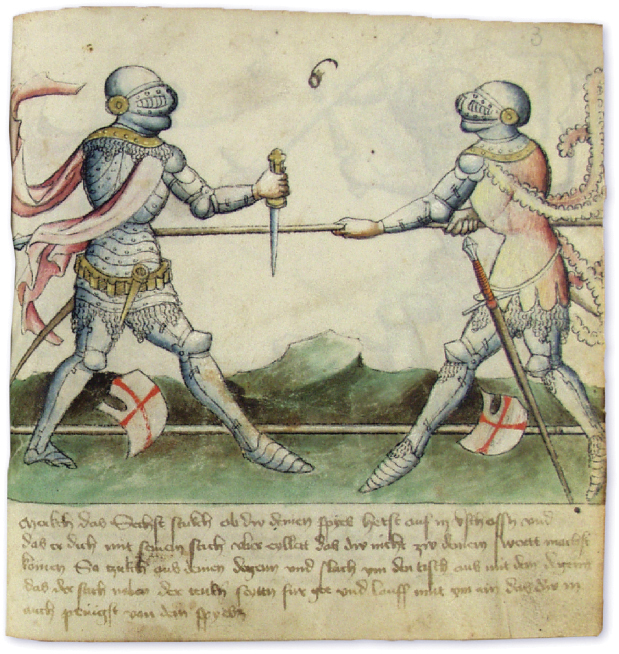
Merkch das Sechst stukch ob dw deinen spyes hetst auf in verschossen vnd das er dich mit seinem stich vber eyllett das dw nicht zw deinem swertt machst kömen So czukch aus deinen degenn vnd slach ym den tischiii aus mit dem degenn das der stich neben der tenken seytt n für gee vnd lauff mit ym ain das dw in auch pringst von dem spyes
| 2V (4V) | SPEAR |

Note the seventh piece. When you have both lost your spears, and if he can get his sword, and strikes strongly downwards at you, then take your dagger in both hands, and catch the sweeping strike between your two hands on the dagger. Thus you will come to wrestle with him for the sword.

Merkch das Sübnt stukch das ir paid von den spyessen komen seÿtt ob er zw seinem swert wer kömen vnd slüg von krefft en nyder auff dich So nÿmb deinn degenn in pede hentt So vach den straich zwischen deiner peder hentt auff den degen So kumst dw mit ym zw ringen vmb das swertt
| 3R (5R) | SPEAR |

Note the eighth piece. Then take your spear strongly to throw it, and observe if you can hit him, so that the throw is not made in vain. Now see if he throws [the spear] at you, then grasp your spear strongly for the thrust, watch where you can hit him well, and hold your spear as far in front as you can.
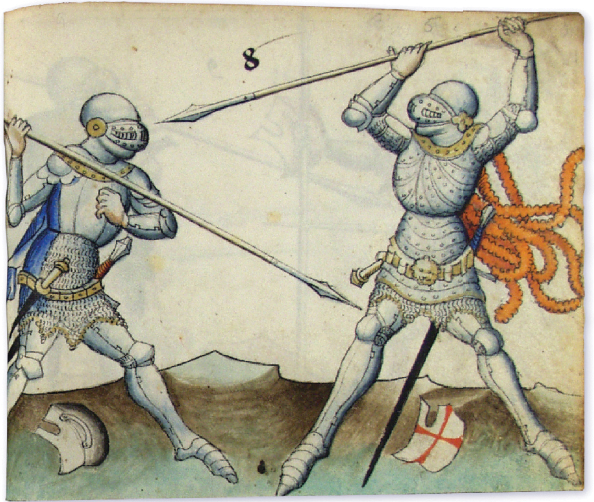
iv [Merkch das acht stukch So nymb deinen spyes mit sterken zw dem schusz vnd merckh ob dw mügest treff n das dw den schuss nicht vmb sunst tüst nw schaw ob er auff dich schüss So nym deinen spyes zw sterckh des stich vnd schaw auff yn wo dw mügest recht treff en vnd halt dich des spyes als lenginst das dw machst]
| 3V (5V) | SPEAR |

Note the ninth [piece]. When he has taken his ecranche7 in his left hand, grabbed the spear for the throw, and goes around you and looks where he can hit you well with the throw, then take your spear and ecranche together, put them in front of yourself on the ground, take your sword in your right hand, and wait for the throw that he intends to make at you.

v [Merkch das Newnt ob er sein tarschen hett genamen in sein tenkche hant vnd den spyes hett gevast zw dem schuss vnd gieng vmb dich vnd schawet wo er dich recht an wolt treff n mit dem schuss So nymb deinen spyes vnd tatschen zw sammen vnd setz für dich auff dy erd nym dein swert in dein rechte hant vnd wart auff den schuss den er dir gemaynt hat]
| 4R (6R) | SPEAR |

Note the tenth [piece]. If he has dropped his ecranche, and grasped his spear and sword together, then powerfully thrusts at you with strength, and wants to press at you strongly, then take your spear and ecranche together, set yourself against him fiercely with strength, and keep yourself as far [away] from him as you can.
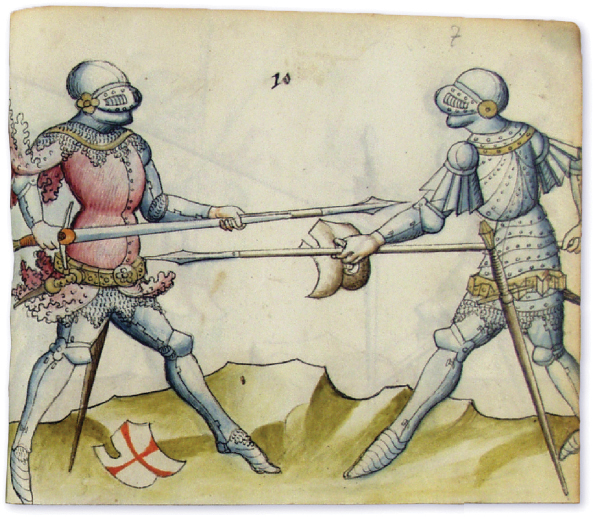
vi [Merkch das zehent ob er sein tatschen hett lassen vallen vnd sein spyes vnd swert zw samb gevast hett vnd krefft ikleich auff dich stech mit sterkch vnd wolt dich hertt ikchleichen aribaitt en So nymb dein spys vnd tatschen zesamb vnd setz dich hertikchleichen mit sterkch wider in vnd halt dich des als lengist dw machst]
| 4V (6V) | SPEAR |

Note the eleventh [piece]. If he has taken his ecranche in his left hand, and brought his spear upwards for the throw, and attempts to throw at you, then take your sword and ecranche together in the left hand, watch carefully for his throw, and catch it on your ecranche. When he has thrown his spear, then jerk your spear upwards for the throw, and immediately throw it at him wherever you can hit him. Thus you will freely come to your sword.
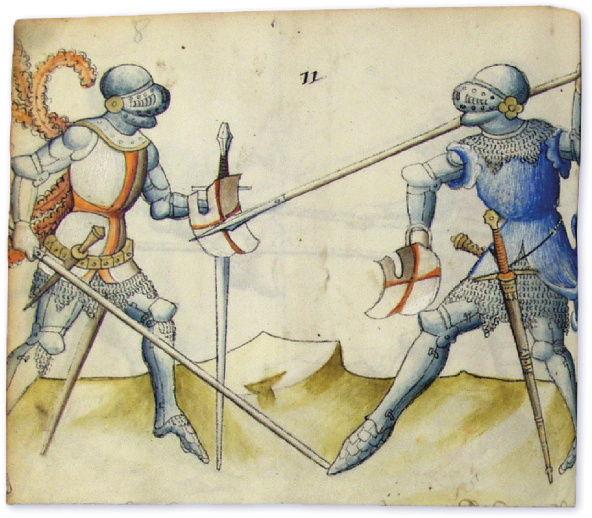
vii [Merkch das Aindlefft ob er seine tatschen hett genomen in sein tenke hant vnd het genomen seinen spyes vbersich auff zw dem schuss vnd wolt dich schiessen So nymb dein swert vnd tatschen zw samb in dye tenkch hant vnd merkch eben auff seinen schus vnd vach den auff dein tatschen wann er seinen spyes verschossen hat so würff deinen spyes vbersich auff zw dem schos vnd scheus fluchs auf in wo dw in treff en kanst So kumst dw fr ey zw deinem swert]
| 4R (7R) | SPEAR |

Note the twelfth [piece]. If you want to finish him quickly, then take your spear and sword together on your arm, unscrew the pommel from your sword, and throw it at him forcefully. Run at him after the throw, and use the sword or the spear, whichever you consider appropriate. If he throws the pommel at you in this way, then set your ecranche in front of yourself and catch the throw with it. Hold your spear in front of yourself in your right hand, ready to thrust. Protect yourself from him, so he can’t run at you as he intends to do.
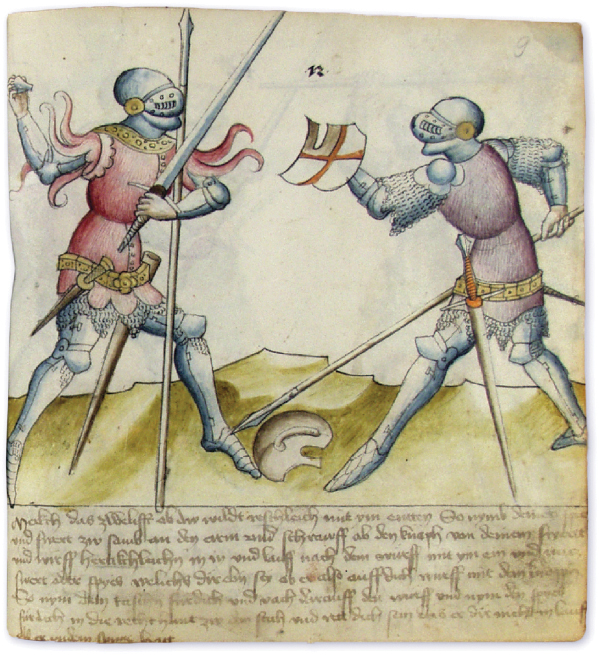
Merkch das zwelifft ob dw wildt reschleich mit ym entt en So nymb deinen spye[s] vnd swert zw samb an den arm vnd schrawff ab den knöph von deinem swertt vnd wirff hertikchleichenviii in in vnd lauff nach dem würff mit ym ein vnd [nütz]ix swert oder spyes welichs dir eben sey ob er also auff dich wurff mit dem knopph So nym dein taschn für dich vnd vach darauff den wurff vnd nym den spyes für dich in die recht hant zw dem stich vnd rett dich sein das er dir nicht in lauff als er yndem synne hatt
| 5V (7V) | SWORD |

Note the beginning of the short sword.8 When you have approached your opponent in the lists9 with all your weapons together – spear, ecranche, sword, and also your dagger – and you have thrown your spear and lost your ecranche, then take your sword in the armoured hand, as you have learnt, and turn10 it upwards over your head to thrust from above, as you see painted above.
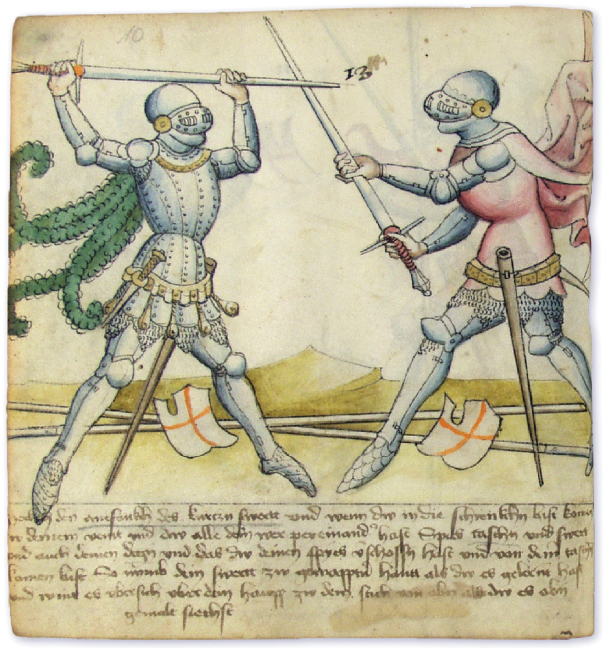
Merkch den anefankch des kurczn swerttx vnd wenn dw in die schrenkchn bist kom[en] [z]w deinem veint vnd dw alle dein wer peyeinander hast Spies taschenx vnd swert vnd auch deinen degen vnd das dw deinen spyes veschossen hast vnd von deiner taschen komen bist So nymb dein swertt zw gewappten hantt als dw es gelernt hast vnd wint es vbersich vber dein haupp zw dem stich von oben als dw es oben gemalt siechst
| 6R (8R) | SWORD |

Note a piece. When he has raised his sword above himself to thrust, and tries to thrust towards your face with strength, then be alert and thrust with the point of your sword moving upwards from below over his left arm and under his sword, and lift with your point strongly upwards. Thus [you] will tear his hand away from the sword, as you see painted.
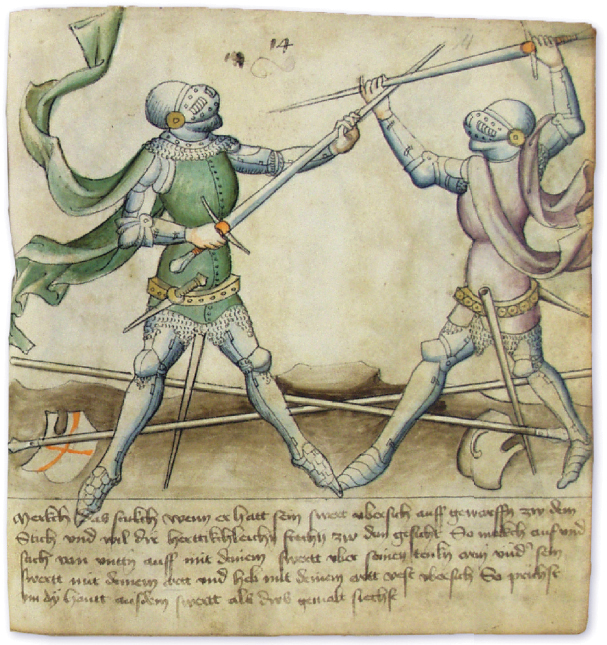
Merkch das stukch wenn er hatt sein swert vbersich auff geworff n zw dem Stich vnd wil dir hertt ikchleichen stechen zw dem gesicht So merkch auf vnd stich von vntt en auff mit deinem swertt vber seinen tenkn arm vnder sein swertt mit deinem ortt vnd heb mit deinem ortt vest vbersich So prichst ym dÿ hantt ausdem swertt als dws gemalt siechst
| 6V (8V) | SWORD |

If he thrusts at you moving upwards from below towards your visor [and] face, and wants to hit you there strongly, then look, grasp your sword short, and watch him closely so that when he strives to thrust at your visor, you hit the inside of his palm with your thrust. Thus you deprive him of his hand, and he will not be able to use it well any more.
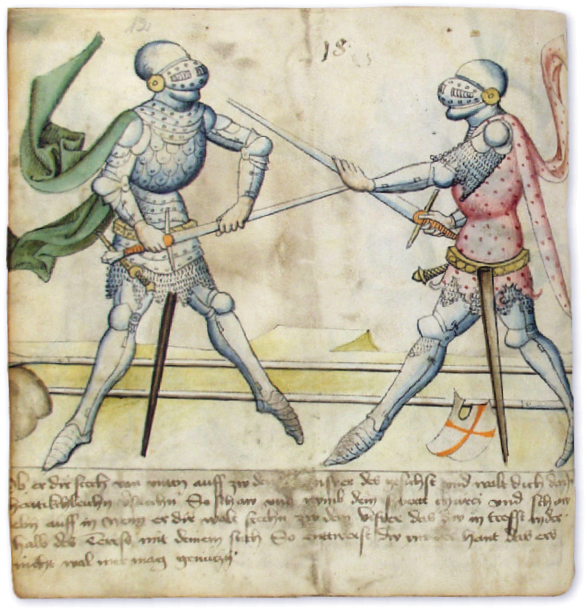
Ob er dir stech von vntt n auff zw de[inem] visyer des gesichst vnd wolt dich darIn hertt ikchleichn versuechen So schaw vnd nymb dein swertt churcz vnd schaw eben auff in wenn er dir wolt stechn zw dem visyer das dw in trefst inderhalb des Tenrss mit deinem stich So entt werst dw ym der hant das ers nicht wol mer mag genüczn
| 7R (12R) | SWORD |

Note a piece, which is called the way of the joints.11 When both thrust at each other with all of their strength, and you want to execute this piece against him, then thrust from the outside of his sword with the point towards him. Drive your pommel between his two hands, catch him with the pommel over his right hand over the wrist, and pull strongly towards yourself. Thus you will break his arm or throw him, as you see painted above.
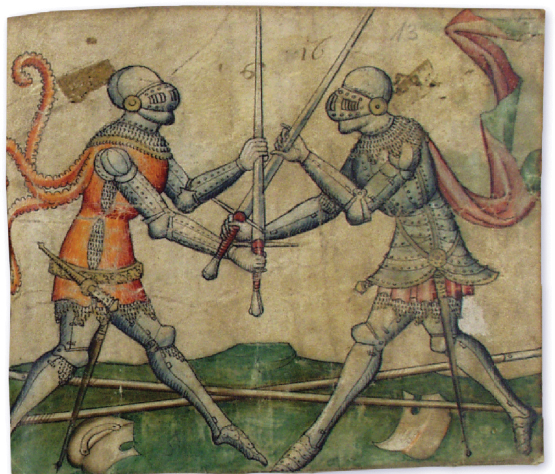
xi [Merck daz stuck daz man heißet die straß der glider Wann einer gen den anderen stech mit ganczer krafft vnd du daz stuck wilt vf In treiben So stich außerhalb seines swertz mit dem ort gen Im vnd var mit deinen knopf zwischen seiner beider hend durch vnd greif Im mit dem knopf vber sein rechte hant vber daz glid vnd ruck vast an dich So brichst Im den arm oder wirfest In als du es oben gemalet sichst]
| 7V (12V) | SWORD |

Note the second piece of the way of the joints. When both thrust at each other, and you want to carry out this piece, then thrust to him yet again outside of his sword, move your pommel between his two hands, catch him with the pommel from the outside over his left arm, and pull strongly towards yourself. Thus you will break his arm or throw him as you see painted above.

xii [Merkch daz ander stukch der straß der glider wan einer aber den vff den andern stech vnd aber daz stukch treiben wil So stich Im aber außerhalb dez swertz vnd var Im durch mit deinem knopf Innerhalb seiner beyder hend vnd greiff Im mit dem knopf außerhalb vber sein tencken arm vnd ruck vast an dich So brichstu Im den arm oder wirfestu In als du es oben gemalt sichst]
| 8R (9R) | SWORD |

If he thrusts at you with all of his strength towards the body from below, then thrust [at] him from above through between his left arm and the sword and lift with the pommel upwards, as you see painted above.
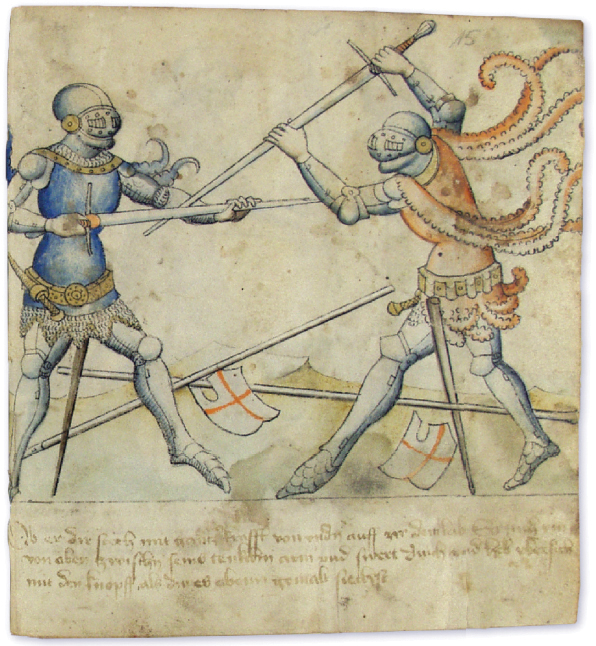
Ob er dir stech mit gancz krafft von vnden auff zw dem leib So stich ym von oben zwischn seins tenkchn arm vnd swert durch vnd heb vbersich mit den knopff als dw es obenn gemalt siechst
| 8V (9V) | SWORD |

If you have both thrust towards the face from the inside of each other’s swords, then press his point downwards with your sword. With your pommel, go between his left hand and the sword from above and pull strongly towards yourself, as you see painted above.
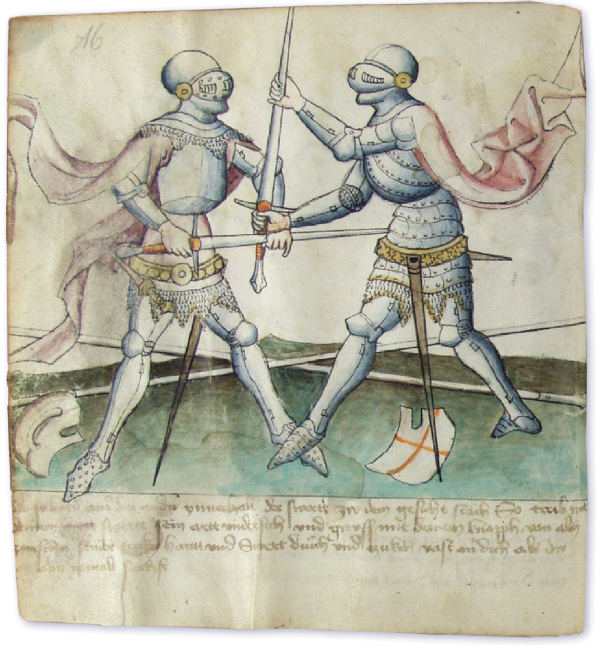
Ob sy bayd ainer den andern ynnerhalb der swertt zw dem gesicht stäch So trib mit dinem [?]xiii swertt sein ortt vndersich vnd greyff mit deinem knopph von oben zwischn seiner tenkn hantt vnd Swert durch vnd czukch vast an dich als dw es obn gemalt siechst
| 9R (10R) | SWORD |

If he has put his right foot forwards, and strikes with a murder strike12 at your head from above, then catch this strike on your sword between your two hands, step with your left foot to the outside of his right foot, and hit his neck from the left side with your point. Thus you will throw him backwards, as you see painted above.

Ob er den Rechtt en fües hett für gesecztt vnd slüeg dir obn den mordslag zw dem haubtt So vach den slach zwischn bayder deiner henndt auf dein Swertt vnd schraÿtt mit deinem tenckn fues ausserhalb seins Rechtt n fües vnd greyff mit deinem ortt an seinen hals zw der tenken seytt en So wirff estu ym vber rukch als dw es oben gemalt siechst
| 9V (10V) | SWORD |

If he has put his left foot forwards, and strikes at your head with the murder strike from above, then catch this strike on your sword between your two hands. Step forwards to the outside of his left foot with your right foot, and catch his neck with your pommel on the right side. Thus you will throw him backwards, as you see painted above.
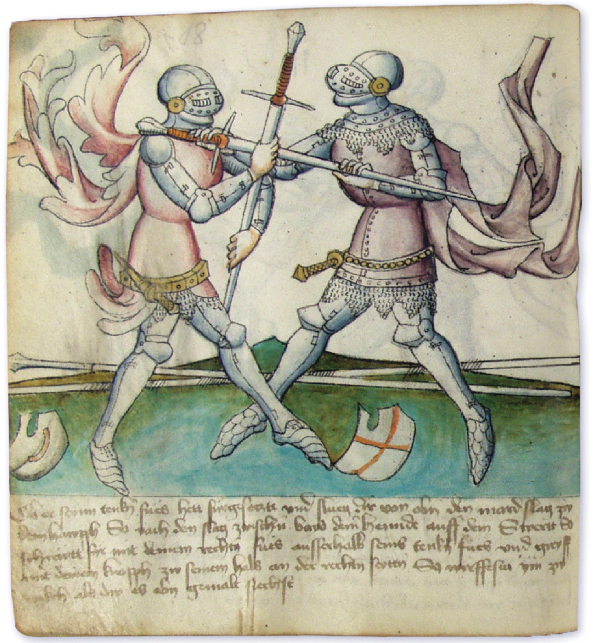
Ob er seynn tenken fües hett fürgesecztt vnd slueg dir von obn den mordslag zw dem hawpph So vach den slag zwischen bayd deiner hennde auff dein Swertt So schraÿtt für mit deinem rechten fues ausserhalb seins tenken fues vnd greyff mit deinem knopph zw seinem hals an der rechten seytt en So wirff estu ÿm zw [ru]kch als dw es obn gemalt siechst
| 10R (11R) | SWORD |

If he has turned his pommel forwards, and strives to shatter your left arm between the elbow and shoulder, then throw your sword forwards to the side, and turn your point upwards. Thus you have parried the strike, as you see painted above.

Ob er seinen knopph hyett für gechertt vnd wolt dir damitt deinen tenken arm zwischen deins ellpogen vnd der achsell ab slachn So wirff dein swert für nach der seytt en vnd ker dein ortt vbersich So hastu den slag verseczt als dw das oben gemalt siechst
| 10V (11V) | SWORD |

If he has turned his pommel forwards, and strives to shatter your right arm between the elbow and shoulder with it, then throw your sword forwards to the side, and turn your point upwards as well. Thus you have blocked his strike, as you see painted above.

Ob er hett seinen knopph für gekertt vnd wolt dir damitt deinen rechten arm zwischen deins ellpogens vnd der achsell ab slachen So wirff dein swert für nach der seytt en vnd ker dein ortt aber vbersich So hastu den slag versecztt als dw es oben gemalt siechst
| 11R (13R) | SWORD |

When you thrust towards his face inside of his sword, then grasp his left hand behind the wrist with your left hand on your sword. Step inside his left foot with your right foot, and lift his arm upwards with your sword. Thus you will throw him forwards, as you see painted above.
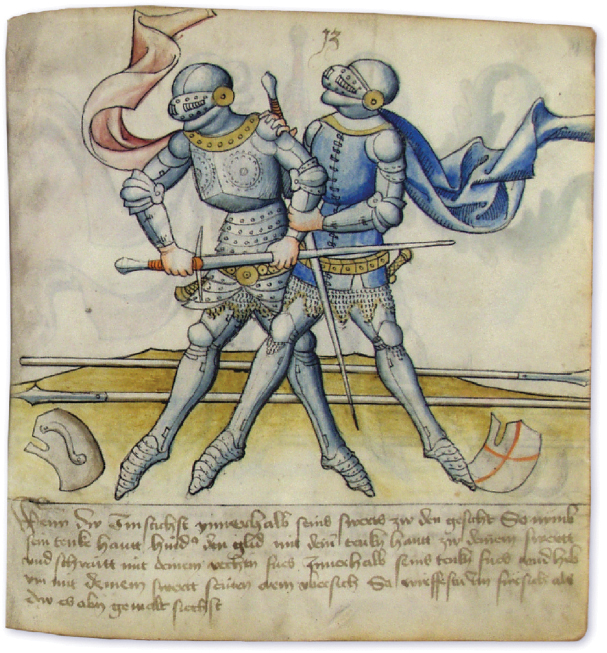
Wenn dw Im stichst ynnerhalb seins swerts zw den gesicht So nÿmb sein tenke hantt hinder den glid mit deiner tenken hantt zw deinem swertt vnd schraitt mit deinem rechten fues Innerhalb seins tenken fues vnd heb ym mit deinem swertt seinen arm vbersich So wirff estu Im fürsich als dw es obn gemalt siechst
| 11V (13V) | SWORD |

This is the break.13 Take note: grasp his left side under his left arm with your left arm, grasp his right knee-bend with your right hand from the outside, and lift upwards. Thus you will throw him on his back, as you see painted above.

Das ist der prüch nw merkch greyff mit deinem tenken arm in seine tenke syt[en] vnder seinen tenken arm vnd greyff mit deiner rechten hant auswendig in sein rechte knyepüg vnd heb vbersich So wirff estw im auff den Rukch als dw es oben gemalt siechst
| 12R (14R) | SWORD |

When you again thrust at his face inside his sword, grab his left hand behind the wrist with your left hand on your sword, step with your left foot inside his left foot, and lift his arm upwards with your sword. When you have brought him to this point, then let your left hand leave the sword and quickly grasp over his neck. With your right hand grasp his left thigh from the inside. Thus you will throw him away from yourself, as you see painted above.

Wenn dw ym aber stichst Innerhalb seins swert zw dem gesicht So nym se[in] tenke hantt hinder den glid mit deiner tenken hantt zw deinem swert vnd schrai[tt ] mit deinem tenken fues ynnerhalb seins tenken fües vnd heb mit deinem swertt seinen arm vbersich wann dw in darzw pracht hast So la varn die tenke hant aus dem swertt vnd greyff ym damit reschleich vber den hals vnd mit deiner rechten hant vass sein tenks diech Innerhalb So wirff estu in von dir als dw oben gemalt siechst
| 12V (14V) | SWORD |

Grasp over his back and under his right armpit with your left arm, and his left thigh from the outside with your right. Pull strongly towards yourself. Thus you will throw him to the ground in front of you, as you see painted above.

Nw merkch den pruch auf das stukch Greyff mit deinem tenken armm vber seynn rukch vnder sein rechtt e vgsenn vnd mit deiner rechten hant ausserhalb an sein tenkchs diech vnd zukch das vast andich So wirff estu In vor dein nyder als dw es oben gemalt siechst
| 13R (15R) | SWORD |

Perform this piece that you know well to conquer his back with. Then lift him straight upwards, strike him with your left knee to the outside of his left knee, and swing him down in front of yourself, as you see painted above.
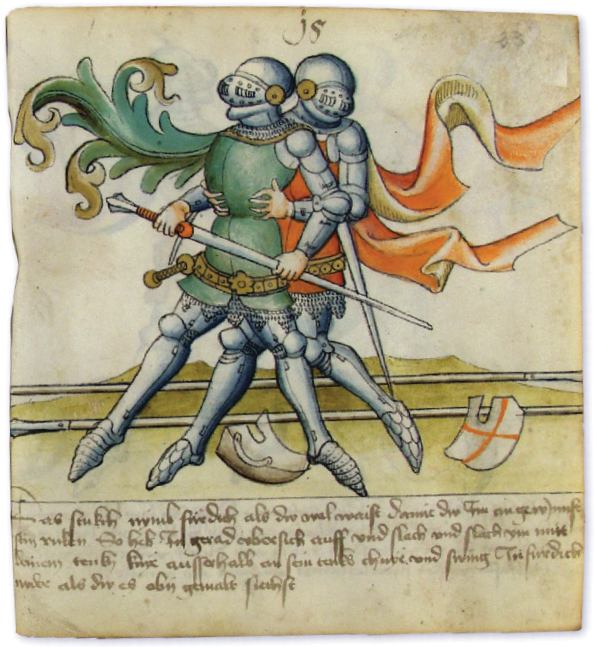
Das stukch nÿmb für dich als dw wol waist damit dw Im angewInnst sein ruken So heb In gerad vbersich auff vnd slach vnd slach [!] ym mitt deinem tenkn knÿe ausserhalb an sein tenks chnÿe vnd swing In fur dich nyder als dw es oben gemalt siechst
| 13V (15V) | SWORD |

Note the piece. When both of you have thrust strongly at each other towards the body, then grasp his left hand at the wrist and both swords together in your left hand, go through with your pommel under his right arm, and jerk strongly upwards. Thus you have taken his sword, as you see painted above.

Merkch das stukch wenn es bayd stecht mit krafft Zu dem leib So nym sein [t]enke hant bey dem glid vnd bayde swertt zw samb in dein tenke hant var [i]m mit deinem knopph v¨nder seinen rechten arm durch vnd rukch vast vber sich So hastu ym sein swert entt wert als dw es oben gemalt sichst
| 14R (16R) | SWORD |

Note the break. Take both points in your left hand, and jerk strongly towards your left side. Grasp him with your left hand over his back, under his right armpit and grasp his left thigh from the outside with your right hand. Throw him in front of yourself, as you see painted above.

Mer den pruch nym bayde ortt in dein tenke hantt vnd rukch vast an de[in] tenke seytt en vnd greyff mit deiner tenken hant vber seinen ruken vnder seine rechtt vgsen vnd greyff mit deiner rechten hant ausserhalb an sein tenkchs diech vnd wirff in von dir als dw es oben gemalt siechst
| 14V (16V) | SWORD |

Note the counter-break. Catch him around his whole body with your left arm. Pull him strongly towards yourself, grab his left knee with your right hand. Throw him with a wrestling technique as you see painted above.
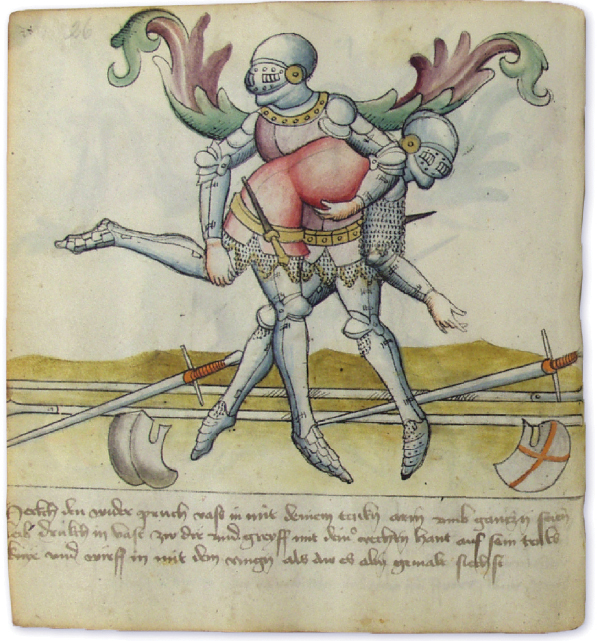
Merkch den wider pruch vass in mit deinem tenkn arm vmb ganczn seien leib drukch in vast zw dir vnd greyff mit deiner rechten hant auf sein tenks knÿe vnd wirff in mit dem ringn als dw es oben gemalt siechst
| 15R (21R) | SWORD |

Note the piece: the beginning of the scissors. If one has grasped the other one’s sword by the point, then throw yourself to the other side of the swords, as you well know. In this way you will free your sword from him. Hold his point still and thrust with your sword over his grip inside his right elbow. Lift upwards, and thus you will deprive him of his sword, as you see painted above.

Merkch das stukch anefang der scher ob ainer dem andern aber das swert bey dem ortt hett ergriff enn So wirff dich durch die swert als dw wol waÿst So hastu dein swertt von Im geledigt vnd halt sein ort vest vnd stich mit deinem swertt vber sin pant Innerhalb seins rechtn ellpugn vnd heb vbersich So ist er seins swerts entt wert als dw es oben gemalt sichst
| 15V (21V) | SWORD |

Note the second piece of the scissors. If he attempts to throw himself to the other side of the sword, then watch for the moment when he turns his back to you. Then throw both swords crosswise over him, and keep him close to yourself, as you see it painted above.
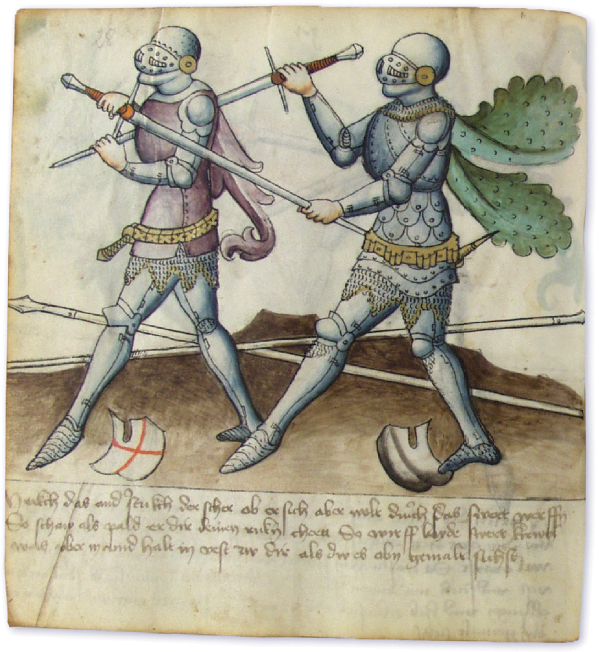
Merkch das ander stukch der scher ob er sich aber wolt durch das swert werff n So schaw als pald er dir deinen ruken chertt So wirff beyde swert krewts weis vber in vnd halt in vest zw dir als dw es obn gemalt sichst
| 16R (22R) | SWORD |

Note a break against both pieces of the scissors. If he has thrown both swords over you, then drop your sword. Grasp the blade of his sword with your left hand and his handle above his hand with the right hand. Thus you have lost your sword, and taken his, as you see painted above.

Merkch den pruch bayder Stukch der schër ob er waid swert vber dich gew[orff en] hett So lasse valln dein Swert vnd greyff mit deiner tenkn hant In sein s[werts] chlingen vnd mit deiner rechten hant ob seiner hant In das pant So bistu [von] deinem swert komen vnd hast Im das sein genomen als dw es oben gema[lt] siechst
| 16V (22V) | SWORD |

Note the piece. If you have both thrust at each other from the outside of the swords towards the face, and [he] attempted to turn your point away, then push strongly away from yourself with the point. Let go of the sword with your left hand, grasp his pommel with it, and lift upwards. Thus you will turn him away from yourself so that he turns his back to you, as you see painted above.

Merkch das Stukch ob ir bayd ainer den andern het gestochen ausserhalben des [s]werts zw dem gesicht vnd dein ort aus hett welln wennden So drukch vast [v]on dir mit deinem ortt vnd lass varen dein tenke hant aus dem swert vnd greyff damit nach seinem swert knopff vnd heb vber sich So wenndestw in von dir das er dir kertt den rukch als dw es oben gemalt sichst
| 17R (23R) | SWORD |

Note a break. Let go of the sword as soon as he has grasped the pommel, and hit his arm behind his left elbow with it. Thus you will do to him what he wanted to do to you, as you see painted above.
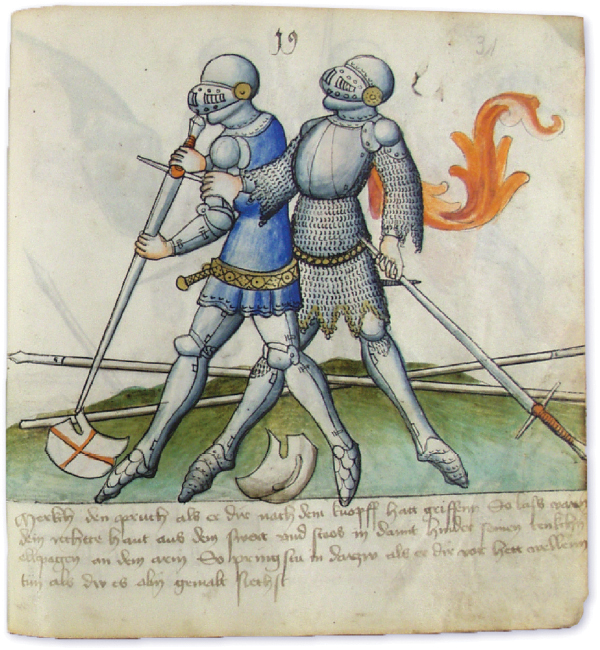
Merkch den pruch als er dir nach dem knopff hatt griff enn So lass varn dein rechtt e hant aus dem swert vnd stoos in damit hinder seinen tenckn ellpogen an dem arm So pringstu in darzw als er dir vor hett wellen tün als dw es oben gemalt siechst
| 17V (23V) | SWORD |

Note the piece. If both swords meet when thrusting to the face from the outside, then catch the hollow of his left knee with your pommel from the outside. Pull strongly towards yourself, and hit him with your left elbow at his breast. Thus you will throw him backwards away from yourself, as you see it painted above.
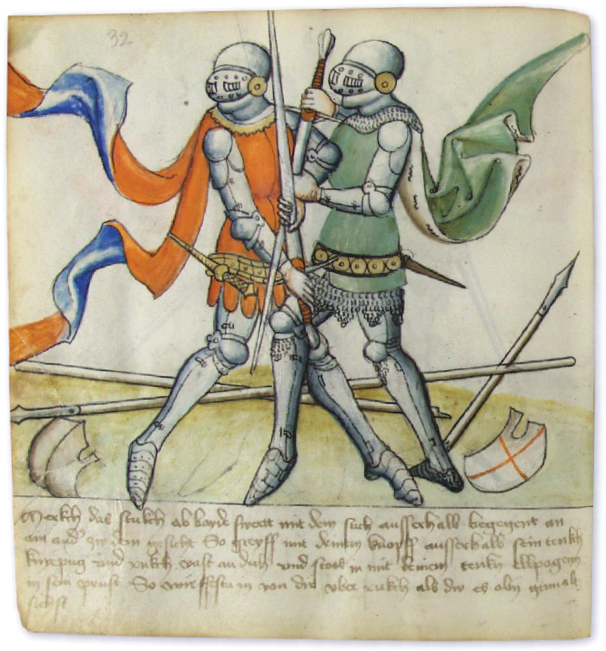
Merkch das stukch ob bayde swertt mit dem stich ausserhalb begegent an ain ander zw dem gesicht So greyff mit deinem knopff ausserhalb sein tenkch knyepug vnd rukch vast an dich vnd stoos in mit deinem tenkn ellpogenn in sein prust So wirff estu in von dir vber rukch als dw es oben gemalt sichst
| 18R (24R) | SWORD |

Note the break. Drop your sword and grasp over the neck at his right shoulder with your left hand. With your right hand, grasp his left thigh from the outside and jerk him upwards. Thus you will throw him down, as you see it painted above.
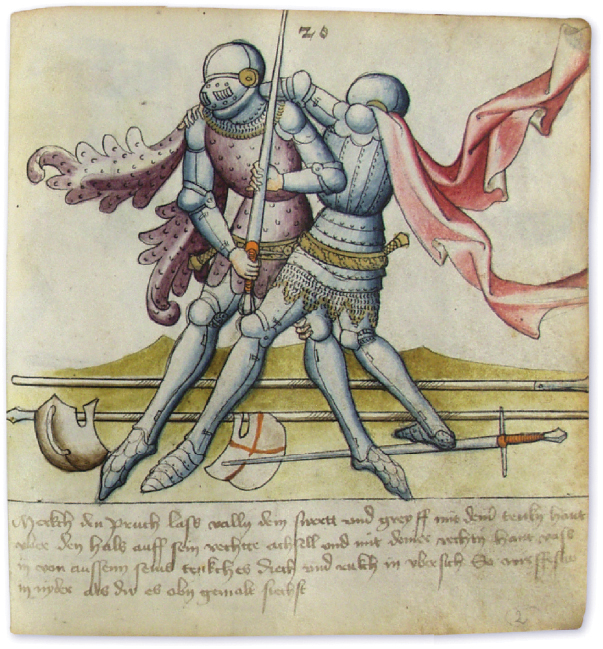
Merkch den Pruch lass valln dein swertt vnd greyff mit deiner tenken hant vber den hals auff sein rechtt e achsell vnd mit deiner rechten hant vass in von aussenn seins tenkches diech vnd rukch in vbersich So wirff estw in nyder als dw es obn gemalt siechst
| 18V (24V) | SWORD |

Note the piece. If both have thrust at each other inside the swords towards the body, then push his point downwards with your sword and catch the hollow of his left knee with the pommel. Pull strongly towards yourself and hit him in his left armpit with your head. Thus you will throw him backwards, as you see painted above.
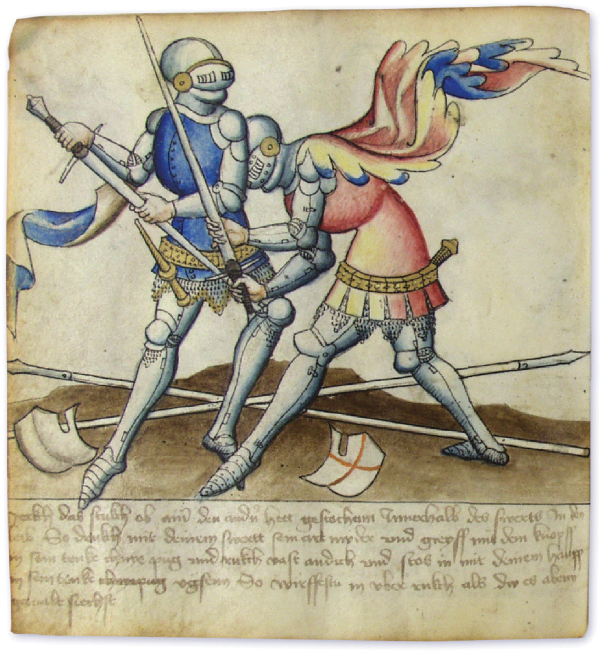
Merkch das stukch ob aine den anden hett gestochenn Innerhalb des swerts In den leib So drukch mit deinem swertt sein ort nyder vnd greyff mit dem knopff in sein tenke chnye püg vnd rukch vast andich vnd stos in mit deinem haupp in sein tenke chnyepug vgsenn So wirff estu in vber rukch als dw es obenn gemalt siechst
| 19R (28R) | SWORD |

Note the piece. If both have thrust at each other strongly towards the breast in such a way that both swords came together on the outside of the bodies, then lift his point strongly upwards with your sword, lift your left foot, and dislocate his leg at the knee, as you see painted above.

Merkch das Stukch ob ainer den andern hertt ikchleich hett gestochenn zw [der] prüst vnd das die Swertt ausserhalb der leib aneinander wern komen So [heb] mit deym swertt sein ortt starkch vbersich auff vnd heb auff deynnxiv fues vnd st[os] ym ab sein pain in dem knÿe als dw es obn gemalt siechst
| 19V (28V) | SWORD |

Note the break. When he attempts to break your left leg with his foot, then pull this foot backwards, step in front of his left foot to the outside with your right foot and catch the right side of his neck with the pommel. Thus you will throw him on his back away from you, as you see painted above.

Merkch den pruch als er dir mit seinem füs hatt wellenn abstossenn seinxv tenks [p]ain So czukch den selbn füs hindersich Schreytt mit deinem rechten fües aussn [fü]r seinen tenken fuessen vnd greyff in mit dem knopff zw der rechten seytt en seins hals So wirff estu in von dir an den rukn als dw es oben gemalt siechst
| 20R (29V) | WRESTLING |

Note the wrestling piece of the scales. When you have both thrust towards each other’s faces from the outside of your swords, then let your right hand leave the sword, and hit him with it at his left arm behind his elbow. Step with your right foot behind his left foot, and move with your right arm strongly around his body. Thus you will throw him, as you see painted above.

Merkch das stukch des ringen aus der wag wenn Si waid zw ein ander stechn ausserhalbxvi der swertt zu dem gesichtt lass varen dein rechtt e hantt aus dem swertt vnd stoos in damitt an seynn tenkn arm hinder den ellpogn vnd schreit mit deinem rechten fües für seinen tenkn fues rukchalben vnd var resc[h] mit deinem rechtn arm vmb seinen leib So wirff estu in als dw es obn gema[lt] sichst
| 20V (29R) | WRESTLING |

Note the piece. If you have come together and begun wrestling, having both lost all your weapons, and he has now quickly recovered his sword, steps forward with his right foot, and strives to strike your down with all of his strength, then put your left foot forwards, and lay your left arm over your right arm. Catch the strike on your two arms in front of the elbows, and grasp his neck with your left hand […]
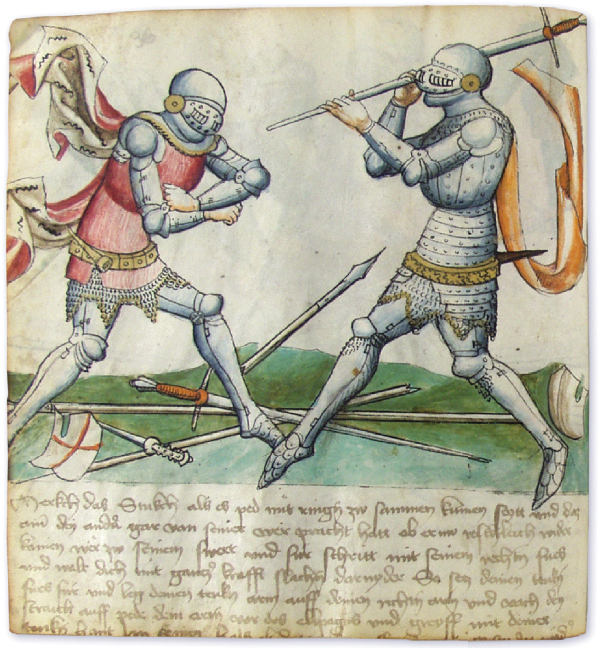
xviiMerkch das Stukch als es ped mit ringen zw sammen kumen seytt vnd daz ainer den andern gar von seiner wer pracht hatt ob er nw reschleich wider komen wër zw seinem swert vnd für schritt mit seinem rechten fues vnd wolt dich mit ganczer krafft slachen darnyder So secz deinen tenken fues für vnd leg deinen tenkn arm auff deinen rechten arm vnd vach den straich auff pede dein arm vor des ellpogns vnd greyff mit deiner tenken hant Im seinen halsxviii
| 21R (30R) | WRESTLING |

Note a wrestling piece. When you have both lost your weapons, and grabbed each other to wrestle by the arms, and both hold each other strongly, then try to strike his arm away with strength. If he holds tight and will not let it go, then move your right arm to the side of his thumb. Strike the inside of his elbow and quickly grasp his left hand with yours. In this way, you will force it behind his back. Step in front of him with your right foot. In this way, you will throw him as you see painted above.
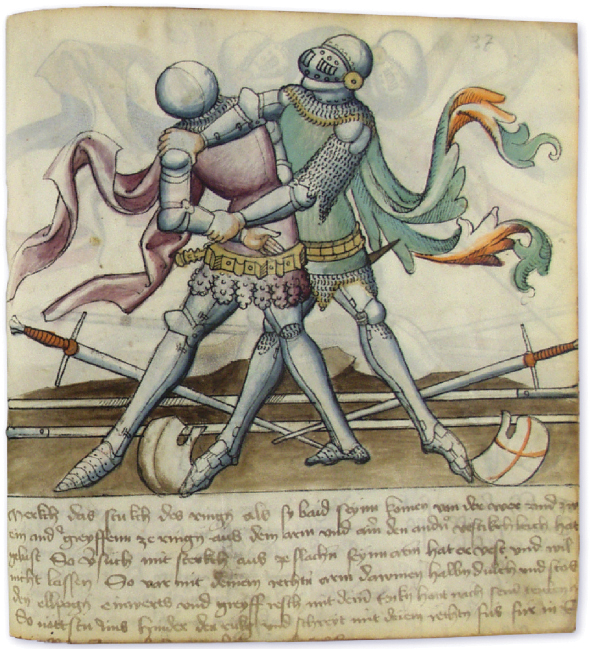
Merkch das stukch des ringn als sy baid seÿnn komen von der wer vnd zw ein ander greyff enn ze ringn aus dem arm vnd ainer den andern vestikchleich hat gevast So versüch mit sterkch aus ze slachen seÿnn arm hat er vest vnd wil nicht lassen So var mit deinem rechten arm dawmen halbn durch vnd stos [im] den ellpogn einwerts vnd greyff resch mit deiner tenken hant nach seiner tenken h[ant] So nött stu Ims hinder den rugk vnd schreyt mit deiem rechtn fus für in S[o wirff estu In als du es oben gemalet sichst]xix
| 21V (30V) | WRESTLING |

Note this, another wrestling piece. When he has grabbed his sword again, hurry and prevent him from grasping it with both hands. If he throws his left hand forwards, and thrusts towards your breast, and tries to prevent you from coming towards him, then quickly grasp his left hand with your right hand, and step forward. Step forward with your head under his armpit and your left arm around his body below. Thus you will throw him over your back on his head, as you see painted above.
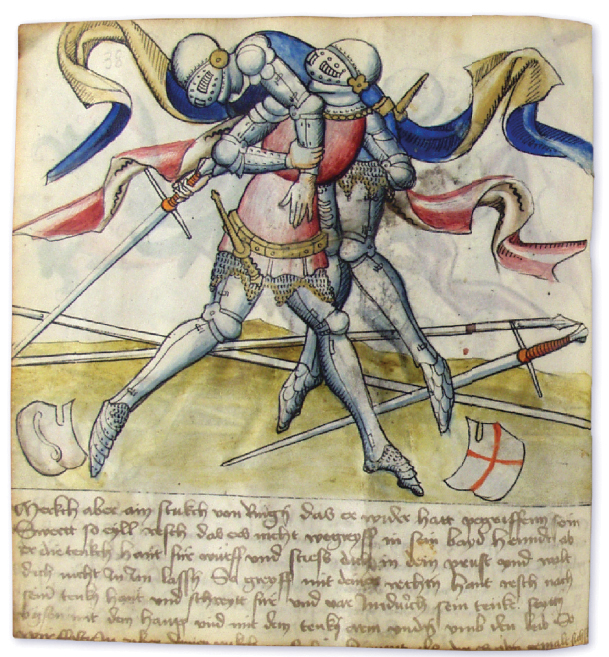
Merkch aber ain stukch von Ringen das er wider hatt pegriff enn sein Swertt so eÿll resch das ers nicht wegreyff in sein bayd henndt ob er die tenkch hant für würff vnd stiess dich in dein prust vnd wolt dich nicht In Im lassen So greyff mit deiner rechten hant resch nach seiner tenkn hant vnd schreytt für vnd var Im durch sein tenke seyttn vgsen mit dein haupp vnd mit dein tenken arm vnden vmb den leib So wirff stu In vber deinen rukch [auf sein haubt]xx als dw es oben gemalt sichst
| 22R (27R) | WRESTLING |

Note the break. When he attempts to grab you, jerk your left foot towards yourself and grab him in the same manner he attempted to grab you. Drop your sword, and grasp him by his left thigh. Thus you will throw him to the ground away from you, as you see painted above.

Merkch den pruch als er dich hatt wellenn vassenn So zukch dein tenkn fues an dich So wegreyff estu in gleich als er dich hatt wellenn vassenn lasse valln dein swertt vnd greyff In nach seinem tenkn diech So wirff estu in von dir auff dÿ erd als dw es obn gemalt siechst
| 22V (27V) | SWORD |

Note the piece. When you thrust towards his face from the inside of the sword and he strives to parry it, then push his sword downward with your point. Thrust your sword towards his neck and let go of the sword with your left hand. Reach around his neck and grasp your sword’s grip again on his right side. Thus you have confined him. Thrust with your dagger as you see painted above.

Merkch das stukch wann dw in Innerhalb des Swerts stichst zu dem gesicht ob er dir den stich wolt verseczen So drukch mit deinem ortt sein Swertt vndersich vnd stos mit deinem swertt an den hals vnd la varen dein tenke hant aus dem swertt greyff Im zw der rechtenn seytt enn vmb den hals wider in dein pant So hastu yn geslossenn vnd stich mit dein degenn als dw es oben gemalt sichst
| 23R (17R) | SWORD |

Note the piece. When both of you have strongly thrust towards each other’s faces outside of the swords, and he attempts to push your point away with strength, then let your point go and step behind his left foot with your right foot. Hit his neck with your sword between your two hands. Thus he will fall, as you see painted above.
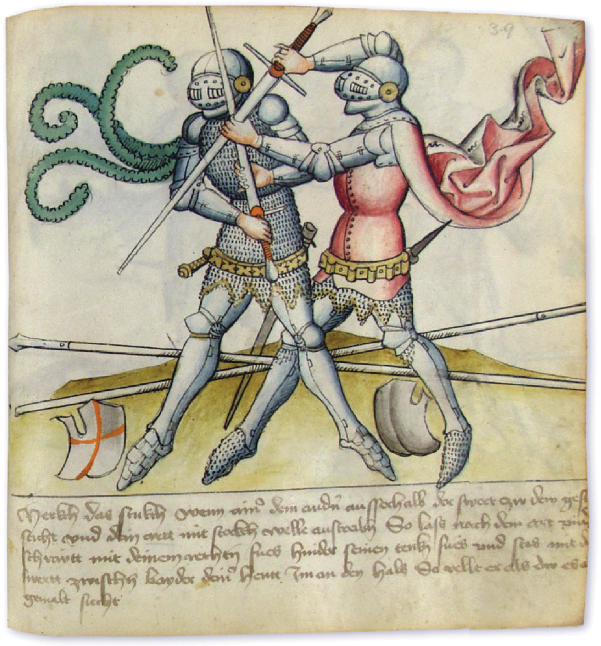
Merkch das stukch wenn ainer dem andnern ausserhalb der swert zw dem ges[icht] sticht vnd dein ortt mit sterkch welle austreiben So lass nach dem ort vnd schraytt mit deinem rechten fues hinder seinen tenkn fües vnd stos mit d[einem] swertt zwischen bayder deiner hentt Im an den hals So vellt er als dw es o[ben] gemalt siechst
| 23V (17V) | SWORD |

Note a piece. If each of you has set your point on the other’s breast, then do not forget the work14 that comes from it, which you know well and is painted hereafter.
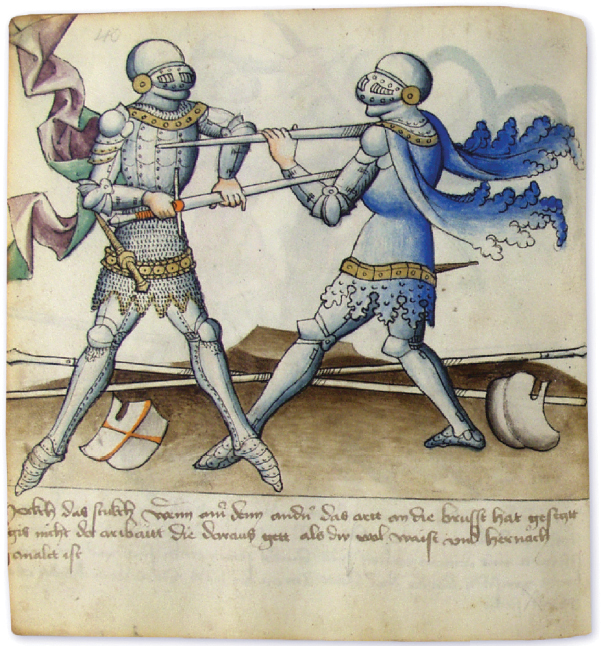
Merkch das stukch wenn ainer dem andern das ortt an die brusst hat gesecztt [ver]gis nicht der aribaitt die daraus gett als dw wol waist vnd hernach [ge]malt ist
| 24R (19R) | SWORD |

Note the break. If he has turned you away from himself with his sword, then grasp him about his neck with your left arm. Grasp him under his right armpit with your hand and drop your sword. Grasp his left thigh from the outside with your right hand and lift upwards. Thus you will throw him, as you see painted above.

Merkch den pruch ob er dich hett geriden von Im mit seÿm swertt So greyff mit deinem tenken arm vber seynn hals vnd vass in mit deiner hant vnder sein[en] rechtn vgsen vnd lass vallen dein swertt vnd greyff mit deiner rechten hantt von aussen in sein tenkes diech vnd heb vbersich So wirff estu in als dw es obn gemalt siechst
| 24V (19V) | SWORD |

Note the piece. When you have both thrust at each other’s body from the outside of the swords, let go of the sword with your left hand. Move your sword under his right armpit and quickly grasp the point again. Lift up, and you will force him to fall, as you see painted above.

Merkch das stukch wenn ir stecht ausserhalb der swertt zw ganczn leib So la varn dein tenke hantt aus deinem swertt vnd küm ym durch mit deinem swertt durch seinem rechte ügsen vnd greyff reschleich wider nach deinem ortt vnd heb vber sich So nott estu In zw dem vall als dw es oben gemalt sichst
| 25R (20R) | SWORD |

Note the break. Turn forcefully as soon as he has thrust under your armpit. Throw your sword towards the left side of his neck so his head is between the sword and your arm. Pull him down to the ground, as you see painted above.

Merkch den pruch als er dir hatt gestochen durch dein vgsen So czukch di[ch] vmb mit chrefft en vnd wirff ÿm dein swertt ze der tenkchen seytt en an d[en] hals damit sein haubt kom zwischn swertt vnd deins arms vnd rukc[h] in widerxxi zw der erden als dw es obn gemalt sichst
| 25V (20V) | SWORD |

This piece also belongs to the pressing15 on the breast. When you both have grasped each other’s point in your hands, then jerk your sword strongly towards yourself. If he strives not to yield it to you, then throw the pommel at his right side. Grasp his left knee from the outside with your left hand. Pull towards yourself and strike his left shoulder with your right hand. Thus you will throw him, as you see painted above.

Das stukch ist auch von dem dringen an die prust komen das ainer dem andern sein ortt hatt ergriff enn in die hant So zukch dein swert vast an dich wil er dirs nicht lassen So wirff ym deinen knoph in sein rechte seytt n vnd greyff mit deiner tenken hant aussen an sein tenkchs knye rukch an dich vnd stoos mit deiner rechtn hant auff sein tenke achsell So wirfestu in als dw es oben gemalt sichst
| 26R (18R) | SWORD |

When you have both pressed your points against each other’s chests, then grasp his left wrist with your left hand. Push him away from you with your point so that you can bring his point under your left armpit. Then thrust your sword against his foot, as you see painted above.

Wenn es mit sterkch an die prüst mit den örtern habt gedrungen So greyff mit deiner tenkn hantxxii vnd stoos in mit deinem ortt von dir damitt dw sein ortt vnder dein tenkche ügsen pringest So stich In mit deim swert in sein fües als dw es oben gemalt siechst
| 26V (18V) | SWORD |

Take careful note of this piece. If you attempt to strike the outside of his left knee with your pommel and he notices this and attempts to parry the strike, then hold fast and thrust through from the outside of his sword under his left leg. Turn him away from you, as you see painted above.
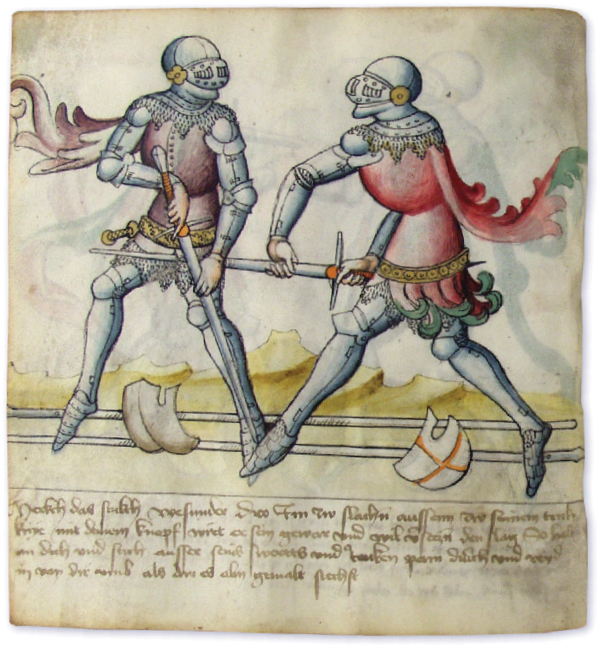
Merkch das stukch wesunder Dw Im zw slachen aussenn zw seinem tenkn knÿe mit deinem knopf wirt er sein gewar vnd vnd wil verseczen den slag So halt an dich vnd stich ausser seins swertt s vnder tenken pain durch vnd reyd in von dir vmb als dw es oben gemalt siechst
| 27R (26R) | SWORD |

Note the work16 of the plate gauntlet. If he throws himself around towards you, and attempts to twist himself out, then step in front of his left foot to the outside with your left foot. Grab him around his whole body with your left arm and hold your point strongly in his gauntlet. Thus you will throw him. However, if he has brought you into the same situation as you did to him before, turn to him and hit his left arm behind his elbow with your right hand to move him away from you. Thus you will free yourself from him.
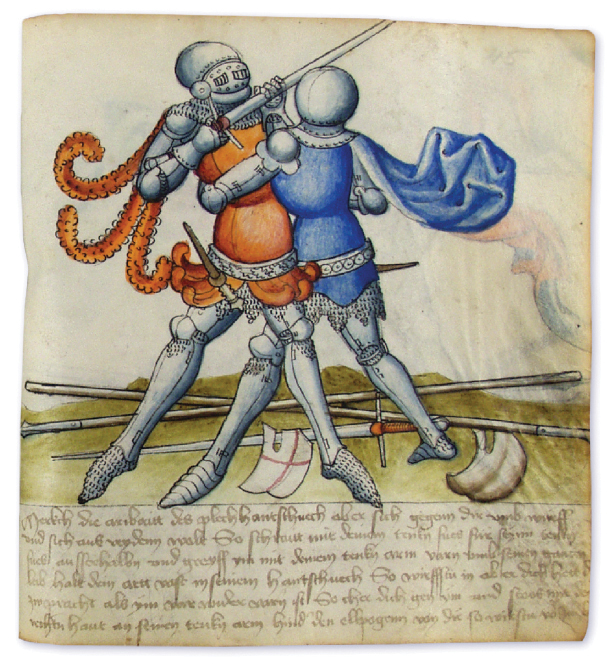
xxiii Merkch die arbaitt des plechhantschuechxxiv ob er sich gegenn dir vmb würff vnd sich aus reydenn wolt So schraitt mit deinem tenkn fues für seynn tenken fues ausserhalbn vnd greyff ym mit deinem tenkn arm vorn vmb seinen ganczn leib halt dein ortt vast in seinem hantschuech So wirff stu in ob er dich hett d[ar] zw pracht als ÿm vor wider varen ist So cher dich gen ÿm vnd stoos mit de[iner] rechten hant an seinen tenkn arm hinder den ellpogenn von dir so wirstu von Im [ledig]
| 27V (26V) | SWORD |

Note the piece. If you both thrust at each other towards the face outside of your swords, then press his point strongly upwards with your sword. Step through with your left foot between his two feet. Grab around his body with your left arm, and his left knee-bend with your pommel. Thus you will throw him, as you see painted above.
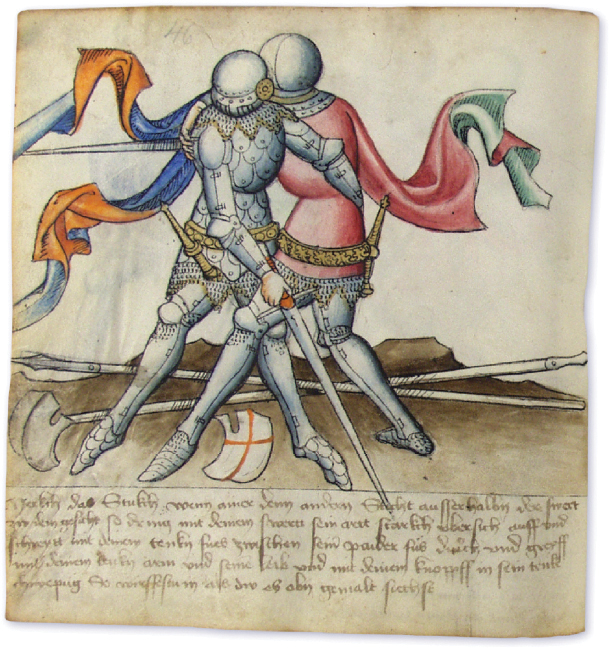
Merkch das Stukch wenn ainer denn andern Sticht ausserhalbn der swert zw dem gesicht so dring mit deinem swertt sein ortt starkch vbersich auff vnd schreytt mit deinem tenkn fues zwischen seiner paider füs durch vnd greyff mit deinem tenkn arm vndxxv seinem leib vnd mit deinem knoppff in sein tenke chnyepüg So wirff estu in als dw es obn gemalt siechst
| 28R (25R) | SWORD |

Note the break. If he strives to throw you backwards in this manner, then grab him under his left armpit over his neck with your left arm. Step with your left foot to the outside of his left foot, and grasp around his left arm above the elbow with your right hand. Throw him down at your feet, as you see painted above.
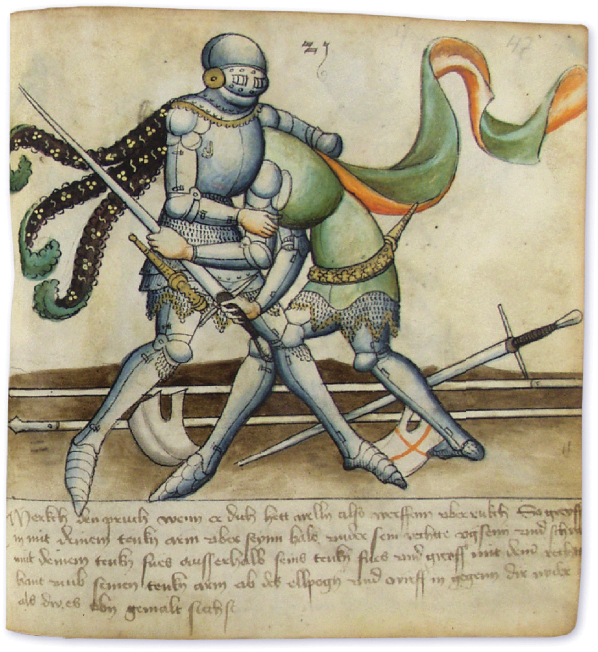
Merkch den pruch wenn er dich hett welln also werff enn vber rukch So greyff in mit deinem tenkn arm vber seynn hals vnder sein rechtt e vgsenn vnd schre[yt] mit deinem tenkn fües ausserhalb seins tenkn fues vnd greyff mit deiner rechtn hant vmb seinen tenkn arm ob des ellpogen vnd wirff in gegenn dir nyder als dw es obn gemalt siechst
| 28V (25V) | SWORD |

Note the piece. In this, the thrust comes towards the gauntlet and frees it from pressing on the breast. Once you have secured him with your point, shove him away from you, as you see painted above.
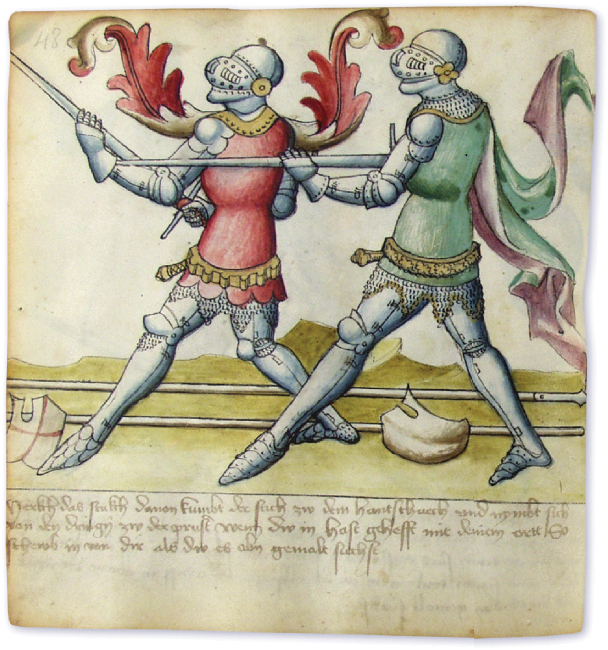
Merkch das stukch dauon kumbt der stich zw dem hantschuech vnd nymbt sich von den dringen zw der prust wenn dw in hast gehefft mit deinem ortt So schewb in von dir als dw es obn gemalt siechst
| 29R (31R) | WRESTLING |

Note the piece. When both of you strive to grasp each other and wrestle, and he grasps you with his right hand, then hit his right arm over the elbow with your left hand. Step forward with your right foot to the outside of his right foot, and grasp around his body with your right arm. Thus you will throw him over your hip, as you see painted above.

Merkch das stukch als sÿ zw ein ander welln greyff en zw ringen ob [er] mit seiner rechten hant nach dir greyfft So stos mit deiner tenkchen hant an seinen rechten arm ob des ellpogen vnd schreyt mit deinem rechten fues für ausserhalb seins rechten fües vnd greyff mit deinem rechten arm vmb seinen leib So wirff estu In vber dein huff als dw es oben gemalt sichst
| 29V (31V) | WRESTLING |

Note the piece. If both of you have grasped each other’s arms and are pulling strongly, then let your left hand go. Use the hand to hit his right arm behind the elbow to the inside to drive it away from yourself. Grasp around his back with your right arm, and with your left hand, grasp his right foot below the knee from the outside. Lift up, and thus you will throw him as you see painted above.
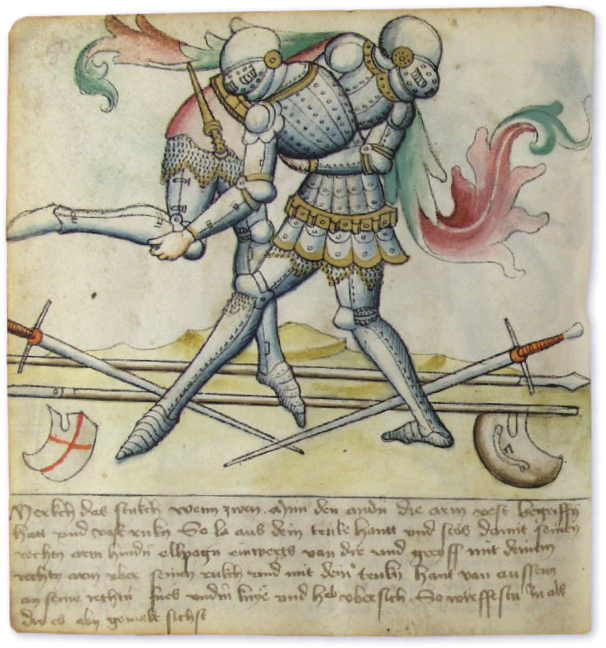
Merkch das stukch wenn zwen aInn den andern die arm vest begriff en hatt vnd vast rukn So la aus dein tenke hantt vnd stös damit seinen rechtn arm hindern ellpogen einwerts von dir vnd greyff mit deinem rechtn arm vber seinen rukch vnd mit deiner tenkn hant von aussenn an seinen rechten fües vnderm knÿe vnd heb vber sich So wirff estu In als dw es oben gemalt sichst
| 30R (32R) | DAGGER |

Note the beginning of six pieces with the dagger from which all wrestling techniques of the limbs, all pieces with the dagger, and the breaks that belong to them are derived. Note whether he has raised his dagger high towards the left side of his shoulder, with his [left] foot forwards.
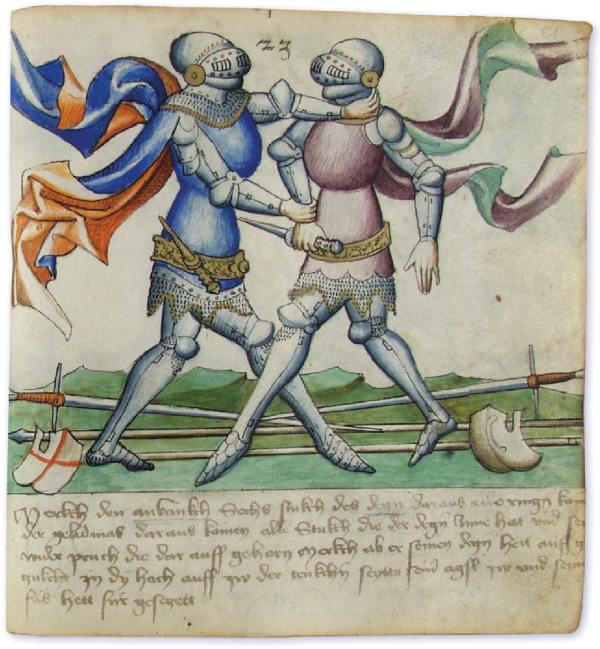
Merkch den anvankchxxvi Sechs stukch des degnxxvii daraus alle ringen kom[en] der gelidmas daraus kömen alle Stukch die der degen Inne hat vnd sei[n] wider pruch die dar auff gehorn Merkch ob er seinen degen hett auff g[e] czukcht In dÿ hoch auff zw der tenkchen seytt en seiner agsl zw vnd sein [?]xxvii füs hett für geseczett
| 30V (32V) | DAGGER |

Note the second piece.17 When he thrusts towards your face with his dagger from above, catch his right hand by the wrist in your left hand. Twist his arm outwards, and thus you have broken his thrust. If you wish to wrestle with him, let go of your dagger and grasp his right elbow from below with your right hand. Pull inwards to your chest, and thus you will break his arm or he must fall.

Merkch das ander stukch ob er dir stech von oben zw dem gesichtt mit seinem degn So vach sein rechte hantt bey dem glid in dein tenke hant vnd reyd ym seÿnn arm auswerts So hastu Im den stich geprochen wildw in bringen zw ringen so lass deinen degenn vnd greyff mit deiner rechten hant von vnden auff sein rechten ellpogn vnd rukch eintt werts gen der brust So prichstu Im den arm oder er mües vallenn
| 31R (33R) | DAGGER |

Note one more dagger piece.18 If he thrusts towards your breast from above and was so quick that you could not reach your dagger, then grasp his hand behind his dagger with your right hand. Strike your left arm over his right arm and set your left hand on your breast. Draw your right hand strongly towards yourself, and thus you will break his arm or throw him down at your feet as you see painted above.
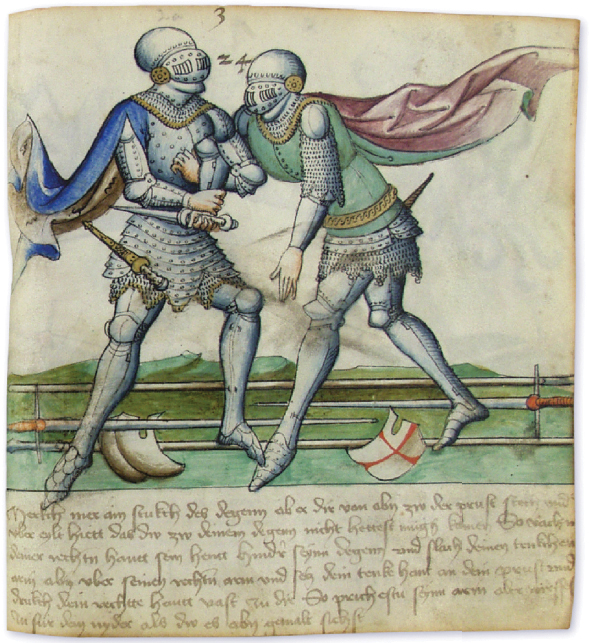
Merkch mer ain stukch des degenn ob er dir von obn zw der prust stech vnd vber eylt hiett das dw zw deinem degenn nicht hett est mügen komen So vach m[it] deiner rechtn hantt sein hentt hinder seÿnn degenn vnd slach deinen tenkchen arm oben vber seinen rechten arm vnd secz dein tenke hant an dein prust vnd drukch dein rechtt e hantt vast zu dir So prichestu seÿnn arm oder wirff e[st] In für dein nÿder als dw es obn gemalt sichst
| 31V (33V) | DAGGER |

Note the third dagger piece. If he thrusts towards your body from below and you could not take hold of your dagger, grasp his wrist behind his dagger from above with your right hand and grasp his elbow from below with your left hand. Lift his arm to your left shoulder, and thus you will break his arm or carry him wherever you wish, as you see painted above.

Merkch das dritt stukch des degenn ob er von vntt n stëch zu dem ganczn leib vnd dw zw deinem degenn nicht kömen wärest So greyff von obn mit deiner rechten hantt auff sein glid hindter seins degenn vnd mit deiner tenkn hantt von vntt en an seinen ellpogen vnd heb seinen arm auff auff dein tenken achsell So zeprichestu seynn arm oder tregst In wo dw In wilt als dw es oben gemalt sichst
| 32R (34R) | DAGGER |

Note the fourth piece. If he thrusts at your face from above, then let go of your dagger, and grasp his hand behind his dagger with your left hand. Grasp his blade with your turned right hand, and thus you will take his dagger and lead him wherever you wish, as you see painted above.

Merkch das vyerd stukch ob er dir von oben stech zw dem gesicht So lass deinenn degn vnd vach in dein tenke hantt sein hant hinden degenn vnd greiff mit deiner vercherten rechten hant in sein chlingn So nymbstu ym seynn degenn vnd pringst in zw wew dw wild als dw es oben gemalt sichst
| 32V (34V) | DAGGER |

Note the fifth piece. If he thrusts upwards from his right side to your body, then grasp his arm behind the dagger with your left hand, and [grasp] the blade with your right hand. Twist downwards, and thus you will take his dagger, as you see painted above.

Merkch das funfft stukch ob er stech von vntt en auff von seiner rechten seytt en zw deinem leib So greyff mit deiner tenken hantt auff seynn arm hinderm degenn vnd mit der rechtenn hantt In sein chlingn vnd reyd ündersich So nymbstu ym den degenn als dw es obn gemalt sichst
| 33R (35R) | DAGGER |

Note the sixth piece. If he thrusts at your neck from his left shoulder, then catch his hand behind the dagger with your left hand. Grasp his blade with your right hand and lift upwards. Thus you will take his dagger. Step to the outside with your left foot, behind his right foot, and strike his breast with your right hand. Thus you will bring him over your leg to fall. You may see the beginning of this painted above.

Merkch das Sechst stukch ob er stech von seiner tenkn agsl zw deinem hals So vach mitt deiner tenken hantt sein hant hindern degenn vnd greiff mitt deiner rechten hantt in sein klingen vnd heb vbersich so nymbstu Im seynn degenn vnd schreitt mit deinem tenkn fues aussenn hinder seinen rechtn fües vnd stos mit deiner rechten hantt in sein brust So vellestu In vber dein pain als dw des anefang obn gemalt sichst
| 33V (35V) | DAGGER |

Note the seventh piece, one of the five parries.19 If he thrusts at your face from above, then catch the thrust on your dagger between your hands. When you have parried the thrust, then quickly grasp his right elbow from below with your left hand. With your right foot, step behind his left foot to the outside, and lift his arm up strongly. Thus you will throw him backwards, as you see painted above.
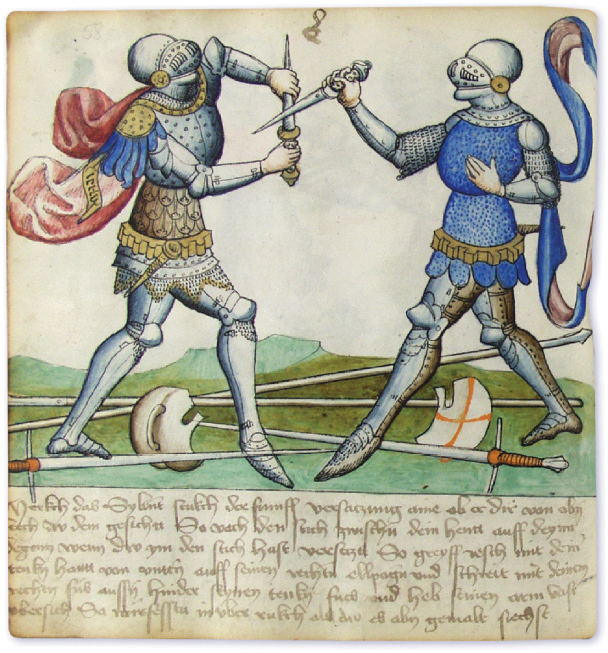
Merkch das Sybent stukch der funff versaczung aine ob er dir von oben stech zw dem gesichtt So vach den stich zwischen dein hentt auff deynn degenn wenn dw ym den stich hast versecztt So greyff resch mit deiner tenken hantt von vntt en auff seinen rechten ellpogen vnd schreit mit deinem rechtn füs aussn hinder seynen tenken fues vnd heb seinen arm vast vbersich So wirfesstu in vber rukch als dw es obn gemalt siechst
| 34R (36R) | DAGGER |

Note the eighth piece. If he thrusts towards your body from below with strength, then drop your dagger, which you hold between your two hands, onto his blade. Thus you will parry his thrust. With your left hand, grasp his wrist behind the dagger, and step to the outside in front of his right foot with your right foot. Grasp his neck on the left side with your right hand, and thus you can throw him down well. You may see the beginning of this painted above.
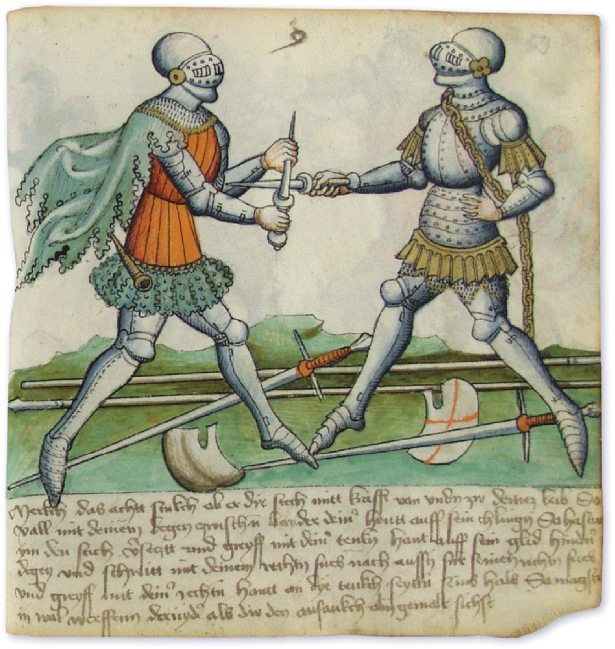
Merkch das achtt stukch ob er dir stech mit krafft von vndn zw deinez leib So vall mit deinem degen zwischn bayder deiner hentt auff sein chlingen So hastw ÿm den stich versecztt vnd greyff mit deiner tenkn hant auff sein glid hindern degen vnd schreitt mit deinem rechtn fues nach aussn für seinen rechtn fues vnd greyff mit deiner rechten hantt an dÿe tenkch seytt en seins hals So magstu in wol werff enn dernyder als dw den anfankch oben gemalt sichst
| 34V (36V) | DAGGER |

Note the ninth piece. If he puts his right foot in front, and thrusts towards your breast from his left side, then catch the thrust on the blade between your two hands. With your left hand, grasp his arm behind the elbow, and push strongly away from yourself, so that he turns his back towards you. You may see the beginning of this painted above.
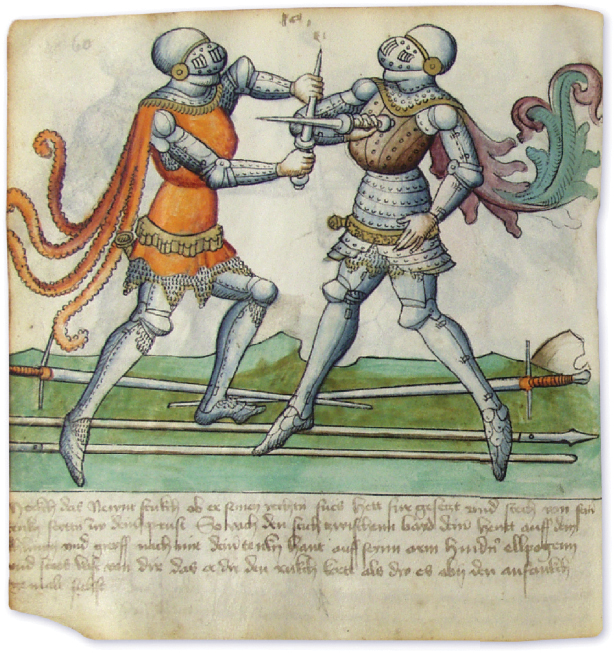
Merkch das Newnt stukch ob er seinen rechten fues hett fur geseczt vnd stech von sein tenkn seytt n zw deiner prust So vach den stich czwischenn bäyd deiner hentt auff dein chlingn vnd greyff nach mit deiner tenkn hant auff seynn arm hindern ellpogenn vnd stoos vast von dir das er dir den rukch kertt als dw es oben den anfankch gemalt sichst
| 35R (37R) | DAGGER |

Note the tenth piece. If he thrusts at your face from above, and you were unable to get hold of your dagger, then lay your right hand on the left crosswise, and catch the thrust on your arms. With your left hand, grasp around his wrist behind the dagger, and with your right hand, [grasp] his blade upwards from below. Thus you will take his dagger. You may see the beginning of this painted above.

Merkch das zehentt stukch ob er von oben zw dem gesicht stech vnd zw deinem degen nicht komen werest So leg dein rechte hant auff die tenkche krewczweys vnd vach den stich auff deinen arm vnd greyff mit deiner tenken hant vmb sein glid hinderwerts degen vnd mit der rechten hant vbersich auff In sein ch[lingen] So nymbstu ymb seÿnn degenn als dw den anevang obn gemalt sichst
| 35V (37V) | DAGGER |

Note the eleventh piece. If he thrusts at your breast from below from the right side, and puts his left foot strongly forwards, and you have failed to reach for your dagger, then drop your crossed hands on his dagger from above. With your left hand, grasp his hand behind the dagger from above, and grasp his blade with your right. Press down, and thus you will take his dagger. You may see the beginnings of this painted above.

Merkch das Aindlefft Stukch ob er von vndtn aus der rechten seÿten stech zu dein prust vnd seinen tenken fües hatt fürgesacztt nach stakch vnd dw deins degenn [ver]sawmt wärest So vall aber mit deinen hentt en krewczweis von obn auff seinen [d]egn vnd greyff mit deiner tenkn hantt oben auff sein hant hindeen degenn [v]nd greyff mit deiner rechten hant in sein kchlingn vnd drukch vndersich So nymbstu im seÿnn degenn als dw den anfanch obn gemalt sichst
| 36R (39R) | DAGGER |

Note the fourteenth piece. If he thrusts downwards at you from above with all of his strength, then parry against his thrust from your right side. Afterwards, hit his right elbow with your left hand so that he turns his back to you. Drive the dagger through his two legs from behind, pull him to you, and grasp the back of his neck with your left hand. Thus you will throw him down in front of yourself, as you see painted above.

Merkch das vyerczehntxxviii Stukch ob er von obn nÿder stech mit ganczer sterkch auff dich So küm von deiner rechten seytn mit versaczunge seins stichs dar na[ch] stös mit deiner tenkn hant seinen rechten elpogen das er dir kertt seinen rukch vnd var durch mit deinem degenn von vndn hinden durch sein bayde pain ruk[ch] an dich vnd greÿff mit deiner tenkn hant hindn auff seÿnn hals So wirff estu In vor dein nÿder als dw es obn gemalt sichst
| 36V (39V) | DAGGER |

Note the fifteenth piece. If both thrust at each other towards the face from the upper right side, and both come close to one another with the parry, then hit his right arm from below with your left arm. Grasp his neck with your left hand, and grasp his legs by going between them with your dagger. Pull towards you, thus you will throw him, as you see painted above.
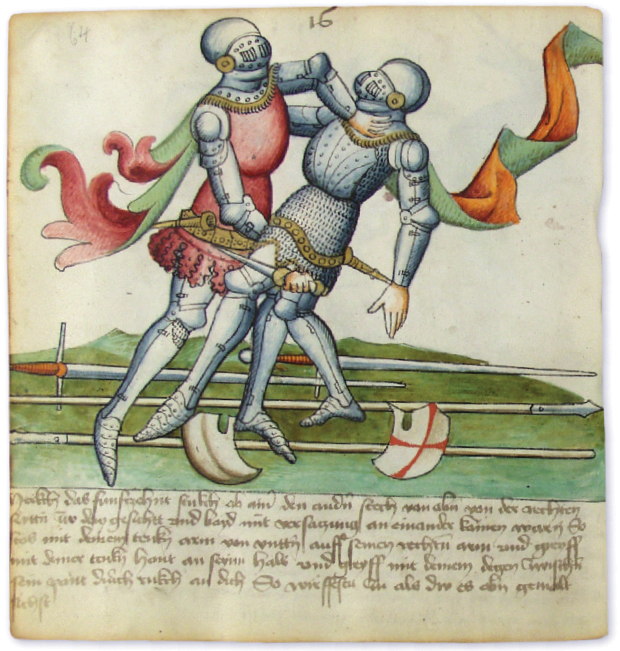
Merkch das funfczehnt stukch ob ainer den andern stech von obn von der rechten seytt en zw dem gesichtt vnd bayd mit versaczung an einander kämen warn So stos mit deinem tenken arm von vntt en auff seinen rechten arm vnd greyff mit deiner tenken hant an seynn hals vnd greyff mit deinem degen zwischen sein pantxxix durch rukch an dich So wirff estu In als dw es obn gemalt sichst
| 37R (40R) | DAGGER |

Note the sixteenth piece. If he thrusts downwards at you from above towards your neck, and you were not able to reach for your dagger, then catch his arm with both hands. Twist his dagger inwards and his elbow outwards, and put your left foot in front of his left foot to the outside.20 Thus you will throw him as you see painted above.
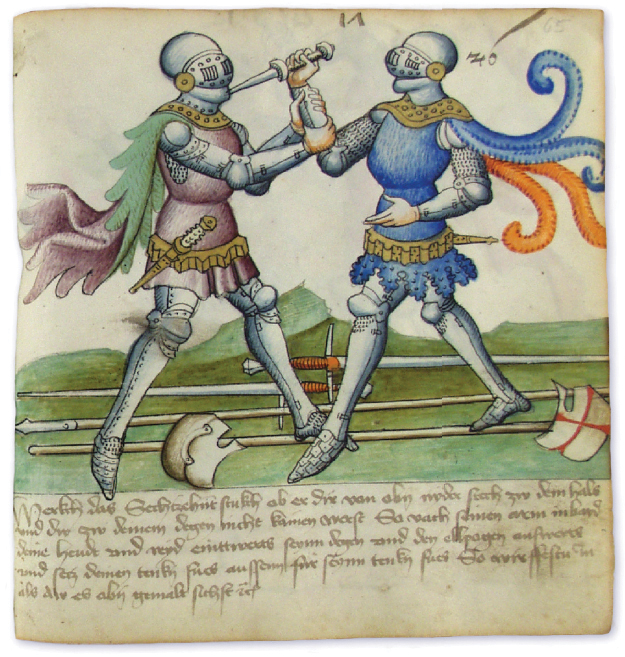
Merkch das Sechczehnt stukch ob er dir von obn nyder stech zw dem hals vnd dw zw deinem degen nicht komen werst So vach seinen arm in bayd deine hendt vnd reyd eintt werts seynn degen vnd den ellpogen auswerts vnd secz deinen tenkn fues aussenn für seynn tenken fues So wirff estu In als dw es oben gemalt sichst etc
| 37V (40V) | DAGGER |

Note the seventeenth piece. When he thrusts at you from above, then grasp around his wrist behind his dagger with your turned left hand, so that his blade comes to the outside of your arm. Step to the outside of his right foot with your right foot, and hit his neck with your right hand. Thus you will throw him, as you see painted above.
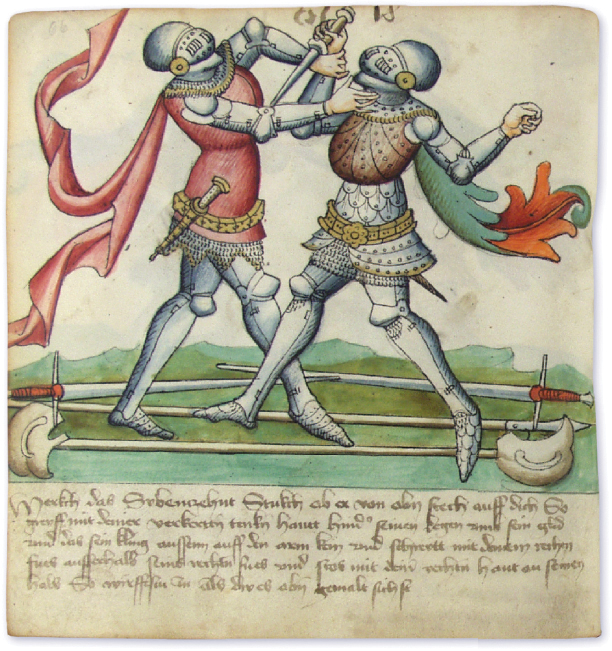
Merkch das Sybenczehnt Stukch ob er von obn stech auff dich So greyff mit deiner verkertt en tenken hantt hinder seinen degen vmb sein glid vnd das sein kling aussenn auff den arm kem vnd schreytt mit deinem rechtn fues ausserhalb seins rechten fues vnd stos mit deiner rechten hant an seinen hals So wirff estu In Als dw es oben gemalt sichst
| 38R (47R) | DAGGER |

Note the thirtieth piece, which is the break to the wrestling from the change.21 If he grabbed your left thigh, and put his left arm on the right side of your neck, then strike his wrist behind the dagger with your left hand, and twist his arm around, so that he turns his back towards you. This way you have broken his wrestling from the change, as you see painted before and above.
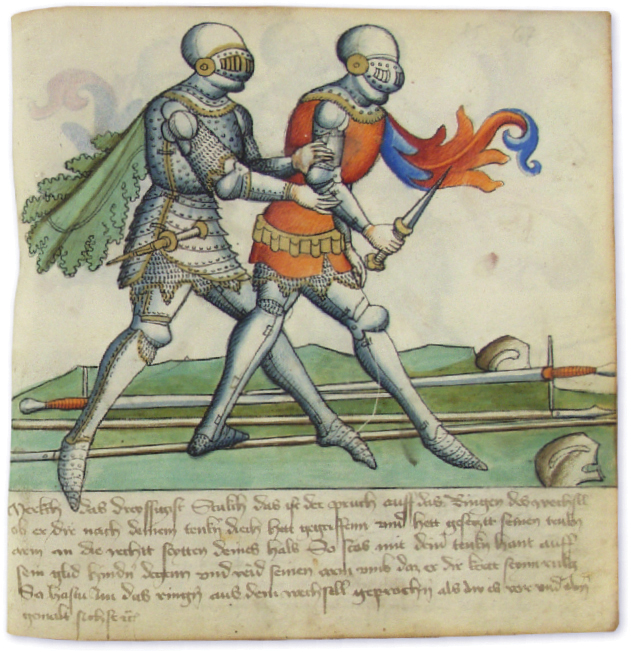
Merkch das dreyssigistxxx Stukch das ist der pruch auff das Ringen des wechsll ob er dir nach deinem tenken diech hett gegriff enn vnd hett gesecztt seinen tenkn arm an die rechtt seytt en deines hals So stös mit deiner tenkn hant auff sein glid hindern degenn vnd reid seinen arm vmb daz er dir kertt seynn rukg So hastu Im das ringen aus dem wechsell geprochn als dw es vor vnd oben gemalt sichst etc
| 38V (47V) | DAGGER |

Note the thirty-first piece. If both have grasped each other in the same way, and each has brought his right arm under the left armpit of the other, and one has strongly swung the other one, and you have then brought him to your left side for the throw, then step forwards to the outside of his right leg. Swing strongly onwards with your right arm, and thus you will throw him downwards, as you see painted above.
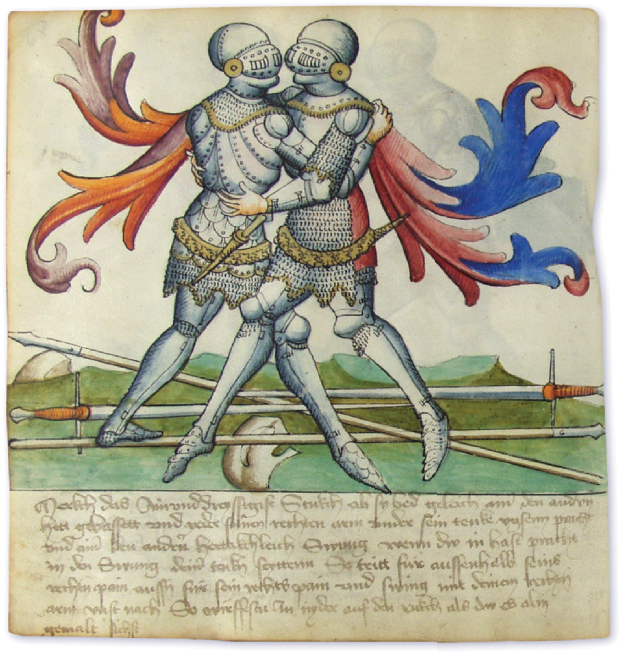
Merkch das Ainvnddreyssigist Stukch ob sy bed geleich ainer den andren hett gevassett vnd yeder seinen rechten arm vnder sein tenke vgsenn pracht vnd ainer den andren hertt ikchleich Swung wenn dw in hast pracht in den Swung deiner tenken seytt enn So tritt für aussenhalb seins rechten pain aussen für sein rechts pain vnd swing mit deinem rechten arm vast nach So wirff estu In nyder auf den rukch als dw es obn gemalt sichst
| 39R (49R) | DAGGER |

Note the thirty-fourth piece of wrestling, which comes from the break of the change. When he puts his right arm on your neck, and strives to grab your leg above your knee with his left hand to throw you backwards, then catch his hand behind his dagger with your right hand and strike it into his groin. Step with your right foot so that you come behind his back. With your left hand, grab through his two legs from behind, and grasp his wrist behind the dagger. Then let your right hand go, and grasp him over the breast with it from the outside. Thus you will throw him, as you see painted above.

Merkch das vyervnddreÿssigistxxxi Stukch des ringen kumbt er aus dem pruch der wechsl ob er dir hett gesecztt sein rechtn arm an deinen hals vnd hett welln greyff enn mit seiner tenkn hant nach deinem pain ob deins knyes vnd wolt dich werff enn vber rukch So vach mit deiner tenknxxxii hant sein hant hindern degen vnd slach Ims in sein schos vnd schreyt mit deinem rechtn fues das dw Im kümbst hinder seinen rukch greyff mit deiner tenkn hant von hindn durch pede seine pain in sein glid hindern degen So la varn dein rechte hant vnd greyf damit von ausse[n vber sein] prust So wirff estu In als dw es oben gemalt sichst
| 39V (49V) | DAGGER |

Note the thirty-fifth piece. If he has put his left foot forward, and thrusts towards your face from his right shoulder from above, then catch his right arm behind the elbow with your right hand. Strike his left shoulder, and grasp above his right arm with your left. Push strongly downwards, and thus you will break his arm or throw him down, as you see painted above.
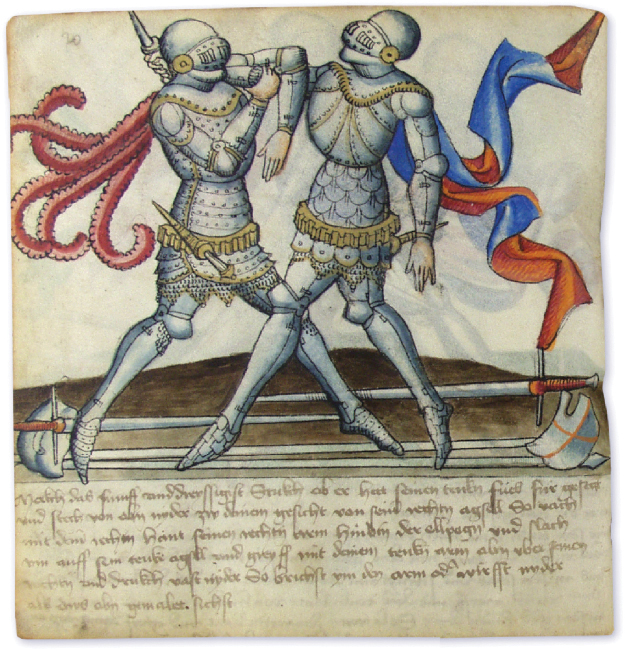
Merkch das funnff vnddreyssigist Stukch ob er hett seinen tenkn fües für geseczt vnd stech von obn nyder zw deinem gesicht von seiner rechtn agsell So vach mit deiner rechtn hant seinen rechten arm hinderm der ellpogn vnd slach ym auff sein tenks agsell vnd greyff mit deinem tenken arm obn vber seinen rechtn vnd druckch vast nÿder So brichst ym den arm oder wirfst nyder als dws obn gemalet sichst
| 40R (50R) | DAGGER |

Note the thirty-sixth [piece]. If he puts his right foot forward, and thrusts downwards at you with all of his strength from above, and strives to rush in at you, so that you can’t reach for your weapons, then throw your left arm over his right arm and pull so that you bring it under your left armpit. Step in front of his left foot to the outside with your left foot, and pull towards yourself. Thus you will throw him, as you see painted above.
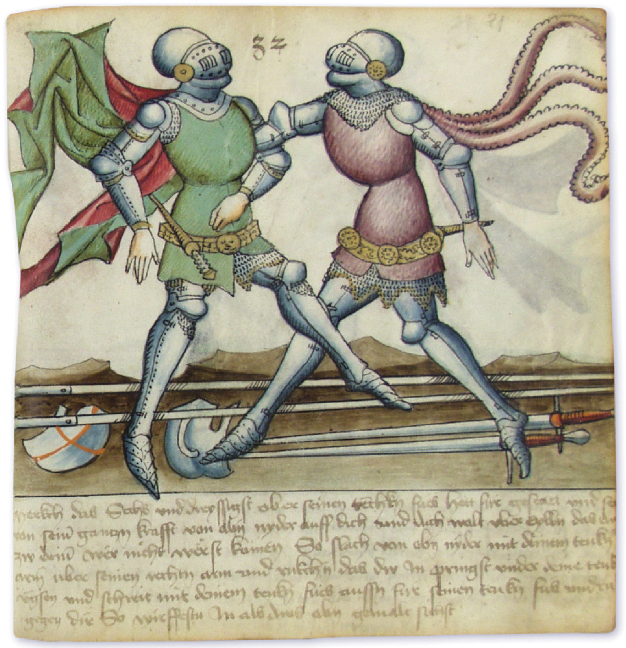
Merkch das Sechs vnddreyssigst ob er seinen rẽchkn fues hett für geseczt vnd s[tech?]xxxiii von seiner ganczn krafft von oben nyder auff dich vnd dich wolt vber eylln das dw zw deiner wer nicht wërst kömen So slach von obn nÿder mit deinem tenkn armm uber seinen rechtn arm vnd rukchen das dw In pringst vnder deine tenk[?] ügsen vnd schreit mit deinem tenken fües aussn fur seinen tenkn fus vnd ru[kch] gegen dir So wirff estu In aks dws obn gemalt sichst
| 40V (50V) | DAGGER |

Note the [piece]. If he thrusts upwards at you from below from his right side, and he has put his left foot forwards, then step inside his feet with your left foot and drop your left hand onto his right hand. Grab his blade with your right hand, and twist the point upwards towards his breast. Thus you will push his dagger into him, as you see painted above.
This is the thirty-seventh piece with the dagger.

Merkch dasxxxiv ob er von vndn auff stech von seine rechten seytt en vnd seinen tenkn fües hett für sacztt So schreytt mit deinem tenkn fües Innerhalb seins fües vnd vall mit deiner tenkn hant auff sein rechte hant vnd greyff mit deiner rechtn hant auff sein chling vnd reÿd vbersich auff deinxxxv ort In sein prust So drukchst dw seinen degen in In als dw es obn gemalt sichst
Das ist das xxxvij stukch des degens
| 41R (52r) | HOLDING DOWN |

Note the third holding piece. When you have begun to wrestle with him, and you grasp him with your left arm in front around his neck, then drop downwards on your left knee, pull him downwards towards yourself on his back, and work22 with your dagger, as you see painted above.
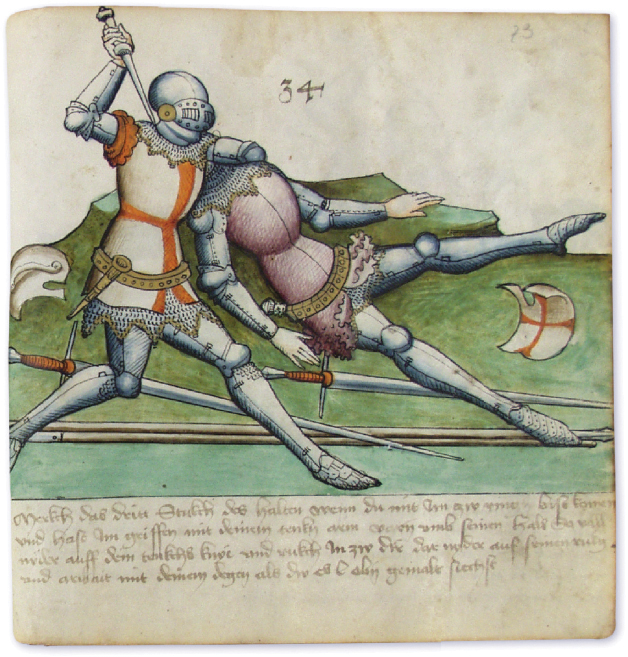
Merkch das dritt xxxvi Stukch des halten wenn du mit Im zw ringn bist komen vnd hast Im griff en mit deinem tenkn arm voren vmb seinen hals So vall nÿder auff dein tenkchs knÿe vnd rukch In zw dir dar nyder auf seinen rukn vnd aribait mit deinem degen als dw es l [!] oben gemalt siechst
| 41V (52V) | HOLDING DOWN |

Note the fourth holding piece. If you have again brought him to his back with wrestling, then drop with your right knee between his legs, and push his right arm down near the shoulder with your left elbow. Lift his visor up at the bevor23 with the same hand, and work with your dagger, as you see painted above.
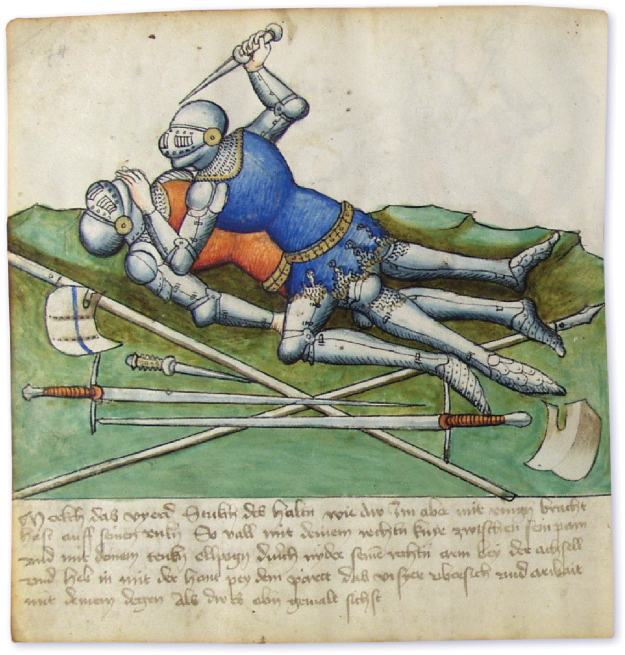
Merkch das vyerd Stukch des halten wie dw Im aber mit ringen bracht hast auff seinen rukn So vall mit deinem rechten knye zwischen sein pain vnd mit deinem tenkn ellpogn durchxxxvii nÿder seinen rechten arm bey der achsell vnd heb in mit der hant pey dem partt das visyer vbersich vnd aribait mit deinem degen Als dw es oben gemalt sichst
| 42R (53R) | HOLDING DOWN |

Note the fifth holding piece. If it so happens that you have again thrown him on his back, then drop downwards on your left knee to the outside of his left leg. If he pulls his foot towards himself, and strives to support himself in standing up, then go under his left knee-bend from the outside with your left hand. Grab his right hand by the wrist, hold it tight and work with your dagger, as you see painted above.

Merkch das funfft Stukch des halten wie das aber chömen ist das dw In auff seynn rukch geworff en hast So vall nÿder auff dein tenks knÿe ausserhalb seins tenkn pain ob er seÿnn fües zw Im czug vnd wolt sich stewren zw dem aufsteen So var ym von aussen mit deiner tenken hant durch sein tenke knyepug vnd greyff sein rechtt e hant bey dem glid halt die vest vnd aribait mit deinem degen als dw es obn gemalt sichst
| 42V (53V) | HOLDING DOWN |

Note the sixth holding piece. If it so happens that you have thrown him on his belly during wrestling, then drop downwards with your right knee next to his right leg, and your left knee on his loin. If he lifts himself on both his arms, and thus strives to stand up, then hit his right arm under his breast with your right hand, grasp his left hand by the wrist with your left hand, turn it behind his back, and hold tight. Draw your dagger, and work, as you see painted above.

Merkch das Sechst stukch des haltn wie das dar kömen ist das dw Im mit Ringen auff seinen pauch geworff en hast So vall mit deinem rechten knÿe neben seins rechtn pain nÿder vall mit deinem tenkn knÿe auff sein lent ob er sich auff baid sein arm gestewrt hatt vnd wolt vnder dem auff sten So slach in mit deiner rechtn hant seinen rechtn arm vnder sein prust vnd greyff mit deiner tenken hant nach seiner tenkn hant bey dem glid vnd dreÿ Ims hinder sein rukch vnd halt vest zukch aus deinn degn vnd aribait damit als dw es oben gemalt sichst
| 43R (54R) | HOLDING DOWN |

Note the seventh holding piece. If it so happens that you brought him to his back during wrestling, then fall with your right knee between his both legs. Take his left hand into your left hand, and pull it under his head. Hold it tight, and work at his face, as you see painted above.
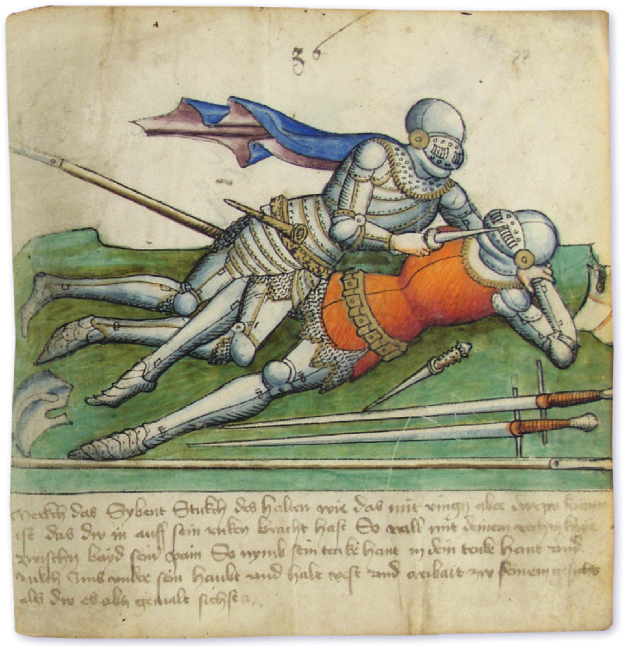
Merkch das Sybent Stukch des halten wie das mit ringen aber darzw kümen ist das dw in auff sein ruken bracht hast So vall mit deinem rechtn knÿe zwischn bayd seiner painxxxviii So nymb sein tenke hant in dein tenke hant vnd zukch Ims vnder sein haubt vnd halt vest vnd aribait zw seinem gesicht als dw es obn gemalt sichst
| 43V (54V) |

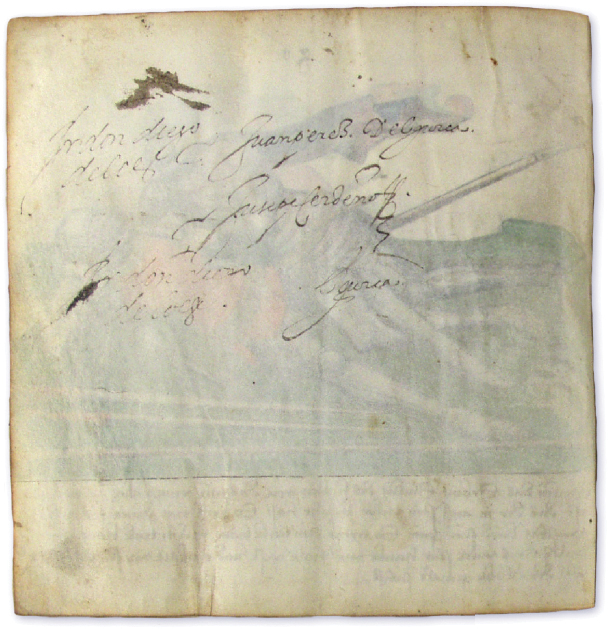

1 Piece = technique, set of movements.
2 “Striking away” in this sense means defending forcefully.
3 Meaning to beat or attack someone.
4 “Armoured hand” means that only the right hand holds the grip of the sword. The left hand grasps the blade in the middle to put more force and accuracy into the thrust. The hand is “armoured” since these techniques are usually performed in harness, thus the hand is encased in an armoured gauntlet, though in some illustrated fencing books, as in the present one, these gauntlets are not depicted. There are very few exceptions, see fol. 27r and 28v, as well as note xxiv. The reason for this is unclear.
5 Meaning to pressure or attack someone.
6 In this case rushing at someone means quickly seeking body contact with the opponent to conquer him with wrestling techniques.
7 A shield with an indentation for the lance, what is referred to as a bouche.
8 The sword itself is not short; only the way of holding it is shortened. It is the same as holding it in the armoured hand (see note 3). This is also called halfsword in other manuscripts.
9 The (wooden) barrier that marks the boundary of the fighting area, for example in an ordeal or judicial duel.
10 Turning (also known as “winding”) usually means a turning motion of the sword executed while maintaining contact with the opponent’s blade.
11 A singular name that does not occur in any other fencing manuscript. The meaning is not entirely clear. One way of reading may be that we have two consecutive techniques: in the first, the first joint, the wrist, is attacked; in the second, it’s the next joint, the elbow.
12 A strike with the pommel. See glossary, p. 279.
13 A counter against a piece.
14 Further attacks and pieces, see note 5.
15 A situation in which both opponents have set their points onto the adversary’s chest, occasionally also referred to as “gedreng”.
16 See note 14.
17 In the versions from both Cracow and Vienna, this is the first dagger technique.
18 This dagger technique is not numbered in the text. Consecutive numbering begins again only with the next, the third piece.
19 A defending and blocking action.
20 In fact, the illustration shows the left foot on the inside, which makes the throw much more difficult to perform. Gladiatoria Cracow is mostly identical. However, the position of the feet in the Vienna version is not so clear, and the foot could indeed be placed on the outside.
21 A technique described in the preceding piece, which is missing here.
22 That is, attacking, seeking and exploiting the openings. See note 14.
23 A bevor is usually a stand-alone piece of armour that was worn in combination with the type of helmet known as a sallet. It was a chin protection, attached to the armour by the means of staples, pins, and leather straps. Quite often, the sallet was worn entirely without a bevor. Calling the chin protection of a closed visored helmet a bevor is rather unusual.

i The manuscript starts with the fourth piece; the first three are missing.
ii Here, “wenn du” is missing not only in this in the manuscript, but also in the Vienna Version (Vienna, Kunsthistorisches Museum, KK 5013, subsequently Gladiatoria Vienna). Completed according to Cracow, Biblioteka Jagiellońska, Ms. Germ. Quart. 16 (subsequently Gladiatoria Cracow).
iii Recte: “stich” (see Gladiatoria Cracow and Vienna).
iv The text portion of this page has been cut off beneath the feet of both fighters. Completed according to Gladiatoria Vienna.
v The text portion of this page has been cut off beneath the feet of both fighters. Completed according to Gladiatoria Vienna.
vi The text portion of this page has been cut off beneath the feet of both fighters. Completed according to Gladiatoria Vienna.
vii The text portion of this page has been cut off beneath the feet of both fighters. Completed according to Gladiatoria Vienna.
viii The word is underlined in pencil.
ix Word illegible; completed according to Gladiatoria Vienna.
x The text is underlined in pencil.
xi The text portion of this page has been cut off beneath the feet of both fighters. Completed according to Gladiatoria Vienna.
xii The text portion of this page has been cut off beneath the feet of both fighters. Completed according to Gladiatoria Vienna.
xiii Illegible deletion.
xiv The word “tencken” is missing here. (See Gladiatoria Vienna and Cracow.)
xv “dein” in Gladiatoria Cracow. In Gladiatoria Vienna it also says “sein”.
xvi “innerhalb” in Gladiatoria Cracow.
xvii Curiously this is the description of a break against a piece which is written underneath the same image in both Gladiatoria Cracow and Vienna (completed according to the Vienna version): “Merkch daz stuck ob du In hast bracht von aller seiner wer von dem Spieß tarzschen Swert vnd degen So ker fur deinen knopf des Swertz vnd slag mit ganczer sterck vff In wo du In weist am herttisten ze treffen da mit daz du In mogst pringen zu der erden”
(Note the piece. When you have taken all of his weapons—spear, ecranche, sword and dagger, then turn the pommel of your sword forward and strike him with all of your strength where you think you can hit him most forcefully. With this, you may take him to the ground.)
xviii The rest of the line vanishes in the cut-off area.
xix Due to the clipping parts of the text are illegible. Completed according to Gladiatoria Vienna.
xx Some words are illegible because of the clipping. Completed according to Gladiatoria Vienna.
xxi “nyder” in Gladiatoria Vienna.
xxii A passage is missing here, completed according to Gladiatoria Vienna: “an das glid seiner tenken hant”.
xxiii While Gladiatoria Vienna has the same text, the one in Gladiatoria Cracow is completely different.
xxiv Interestingly, this is one of only two images showing fighters with gauntlets. In the present manuscript, the chronological order is mixed up since the second action with gauntlets, which is on fol. 28v, is situated before this one in both Gladiatoria Cracow and Vienna; this is also in line with the actual sequence of the technique.
xxv Recte “vmb”, s. a. Gladiatoria Cracow and Vienna.
xxvi “anvankch” and “degn” have been underlined in pencil by a later hand.
xxvii Since this image appears only in Gladiatoria Vienna—unfortunately without text—but not in the version from Cracow, a completion cannot be provided here. The illustration, however, suggests the left foot.
xxviii Pieces 12 and 13 are missing.
xxix Recte “pain”, see Gladiatoria Cracow and Vienna.
xxx Pieces 18 to 29 are missing.
xxxi Pieces 32 and 33 are missing.
xxxii “rechten” (= right) according to Gladiatoria Cracow and Vienna, which is also much more in line with the flow of the piece.
xxxiii Gladiatoria Cracow does not contain this piece at all, and the Vienna version presents the illustration, but not the text. Completions following other manuscripts must therefore be omitted.
xxxiv The word “stuck” is missing here (see Gladiatoria Vienna).
xxxv “den” (= the), instead of “dein” (= your), according to Gladiatoria Cracow and Vienna, which would be more in line with the flow of the piece anyway.
xxxvi Pieces one and two are missing.
xxxvii Recte: “drukch”, as in Gladiatoria Cracow and Vienna.
xxxviii The Cracow version offers some more detail here:
“vnd greÿff mit deinem rechten fueß v¨ber seinen tencken rist so helst du In den fueß daz er daz pain nicht mag an sich gezihen”.
(Go with your right foot over his left instep. Thus you secure his foot so that he cannot pull the leg towards himself.)